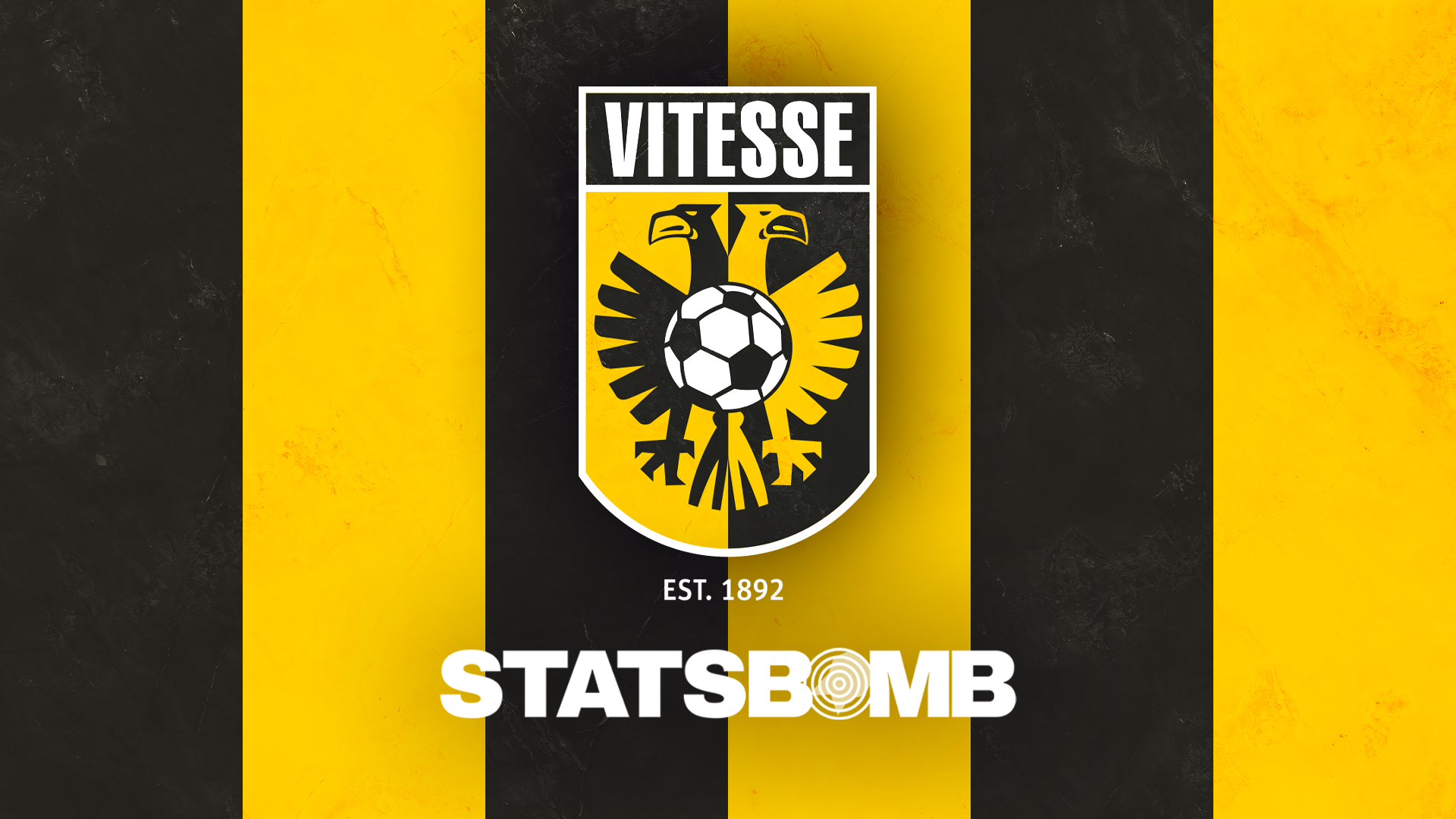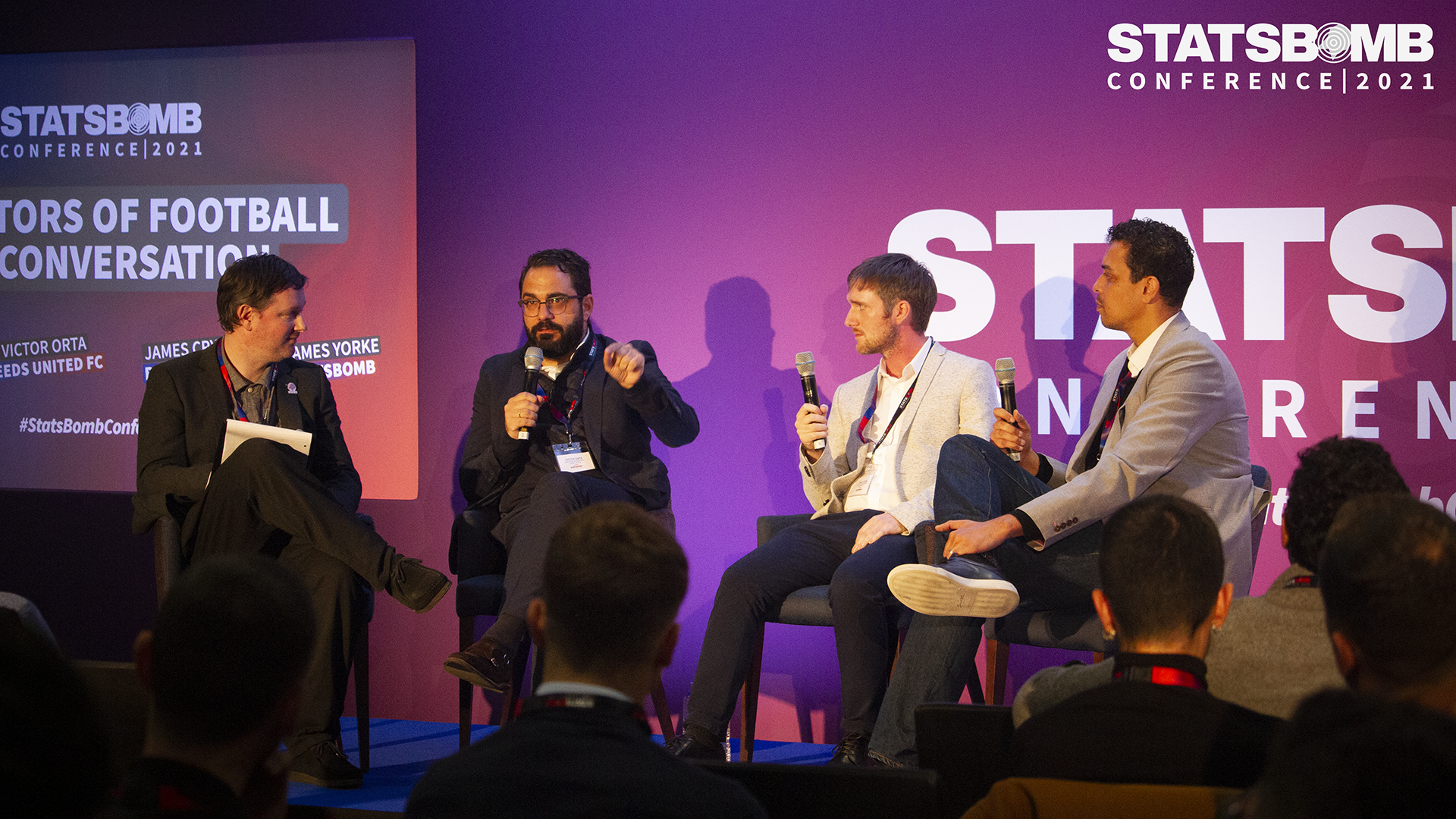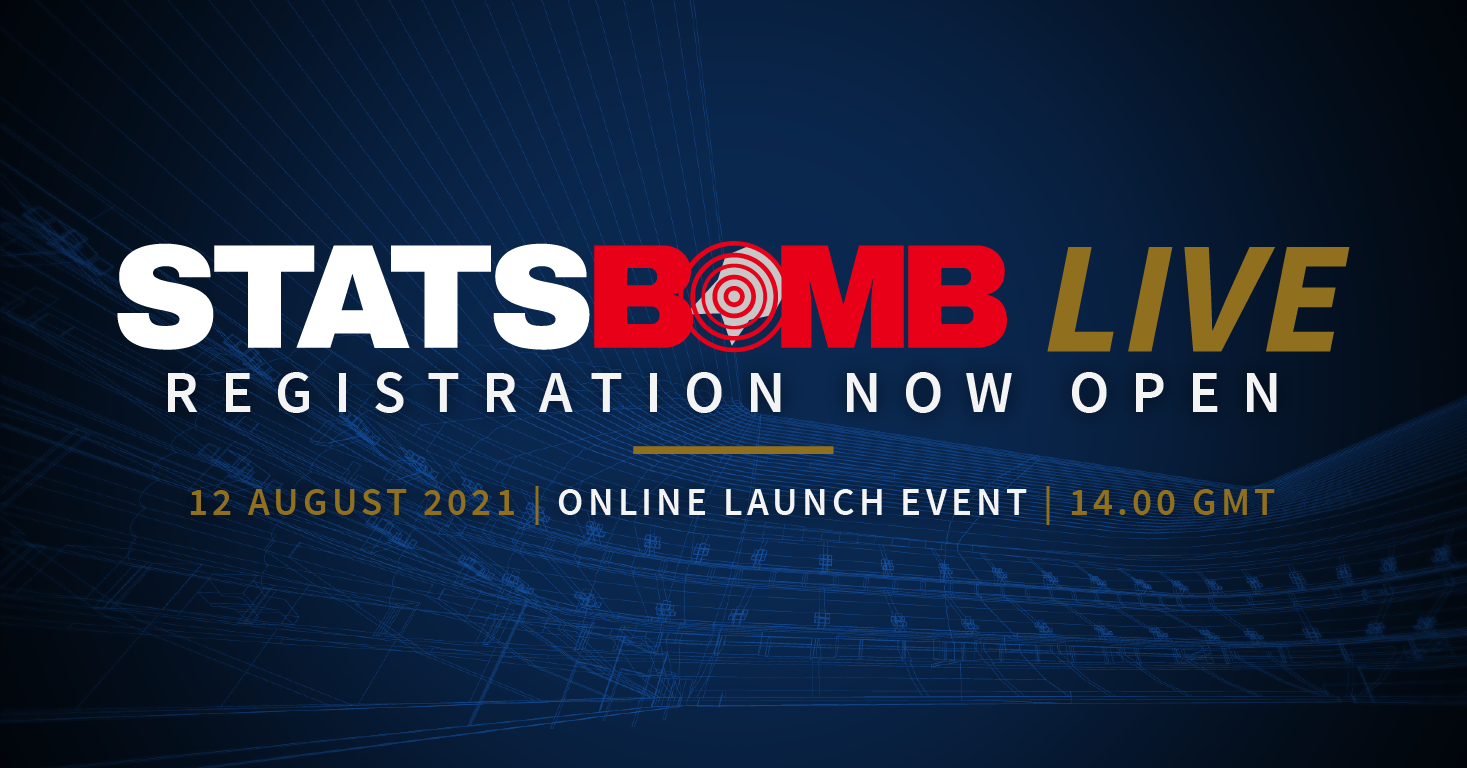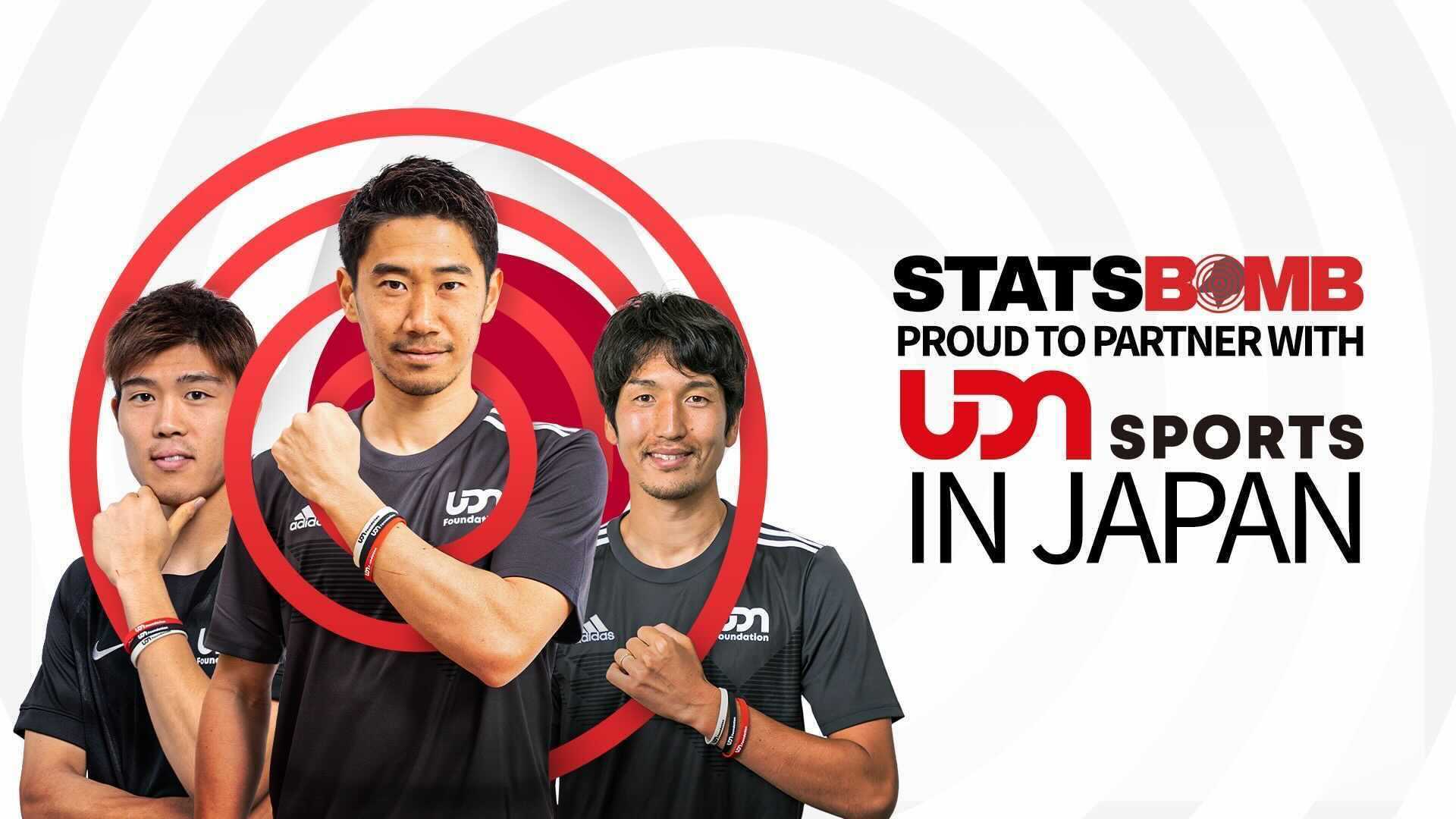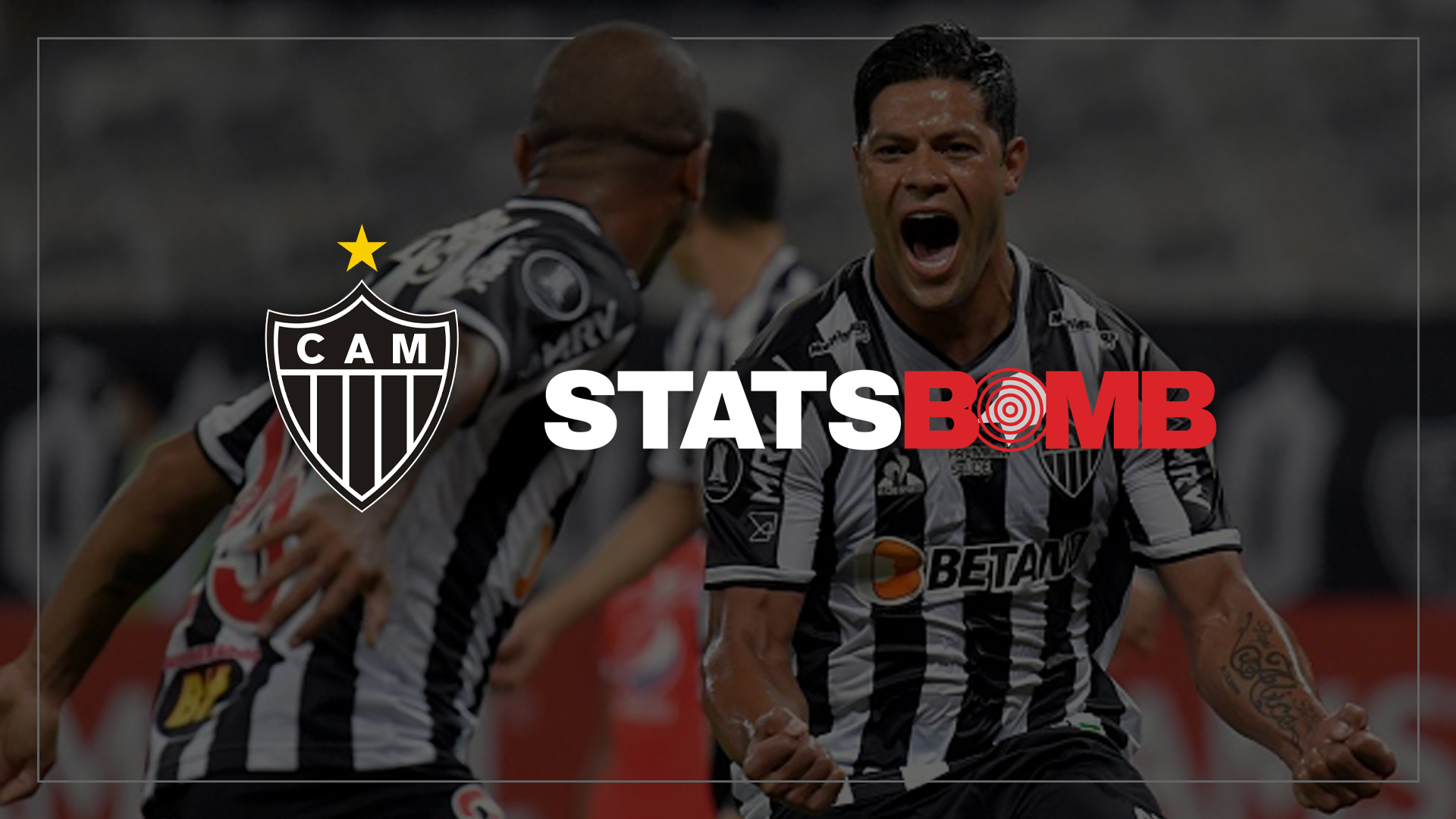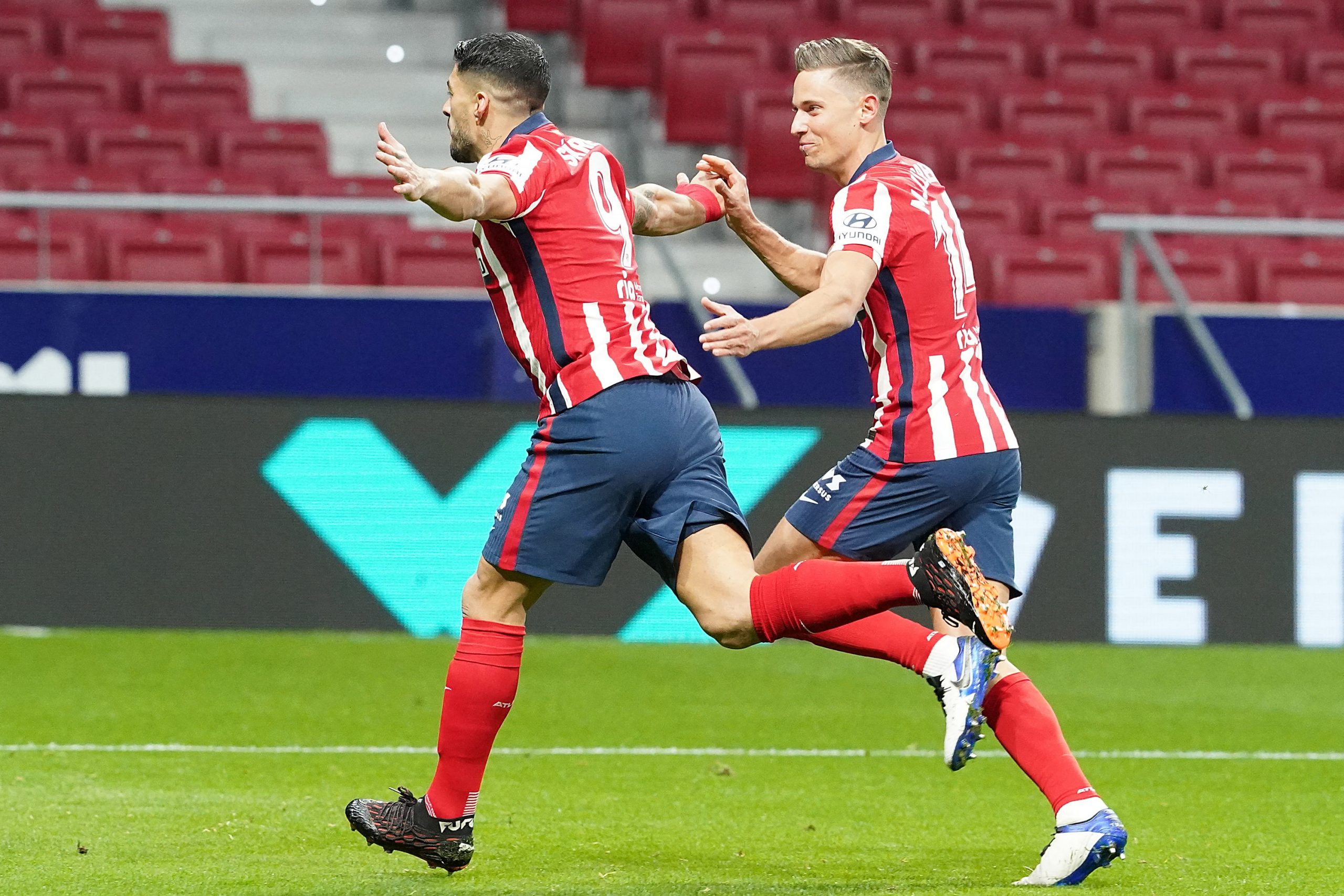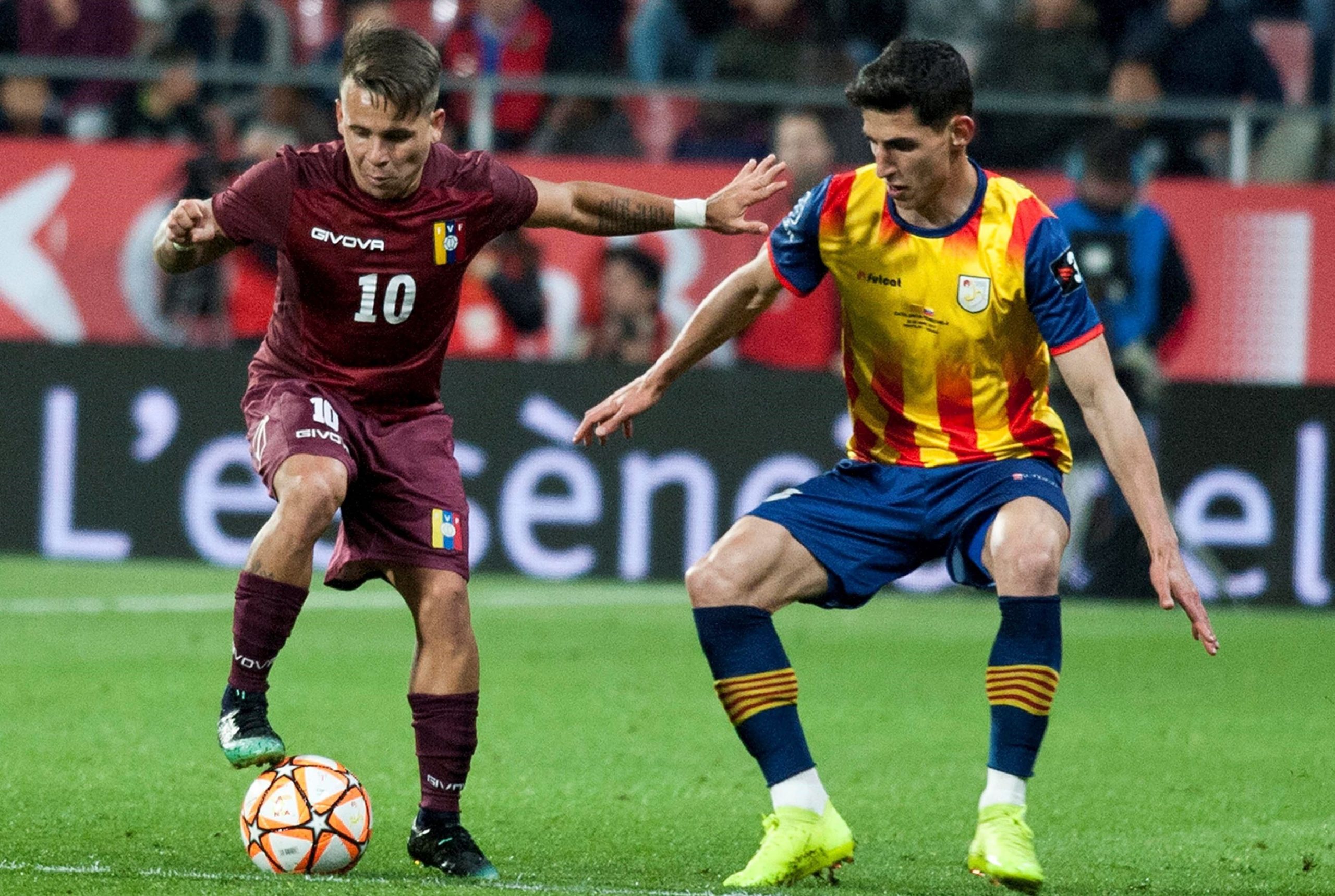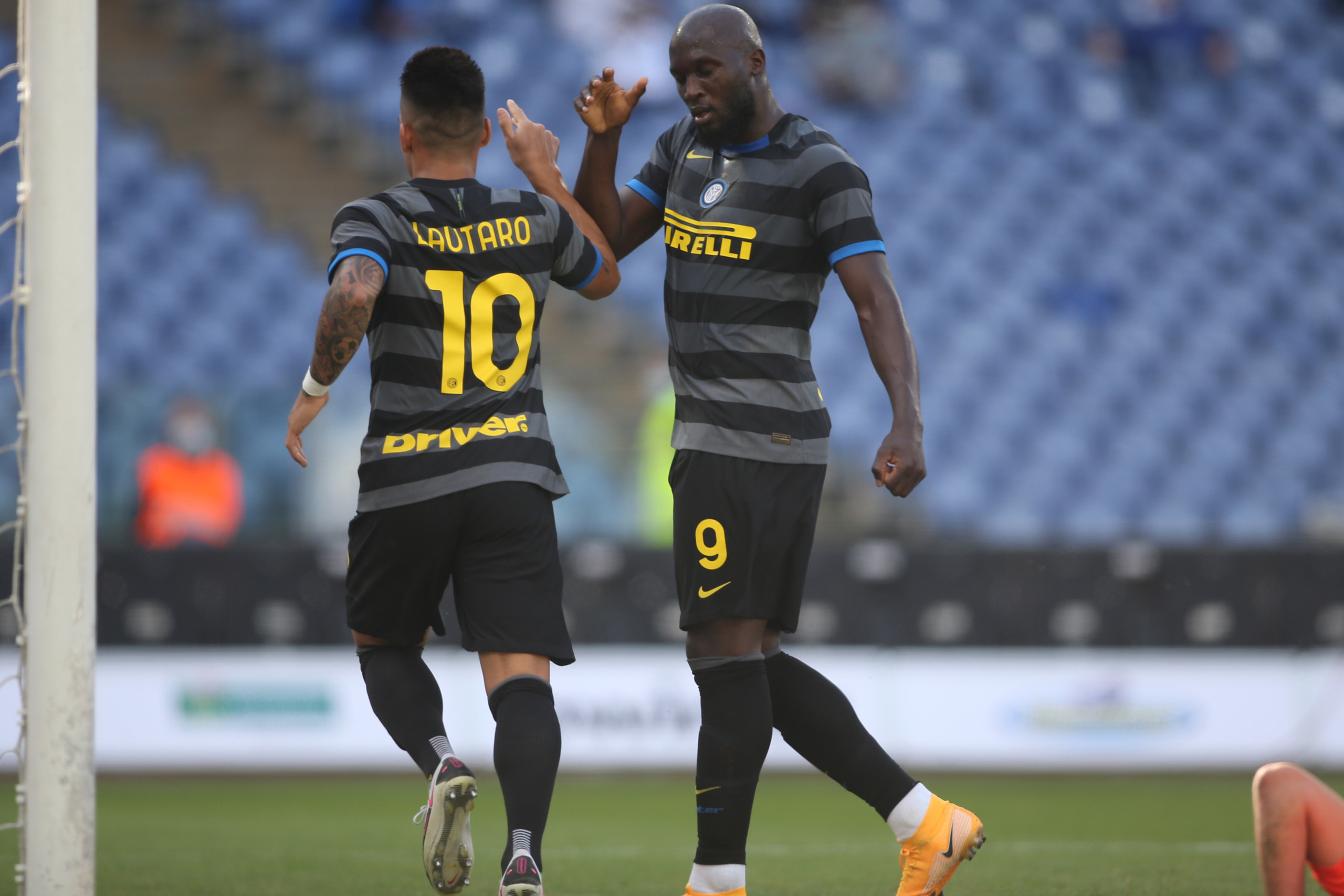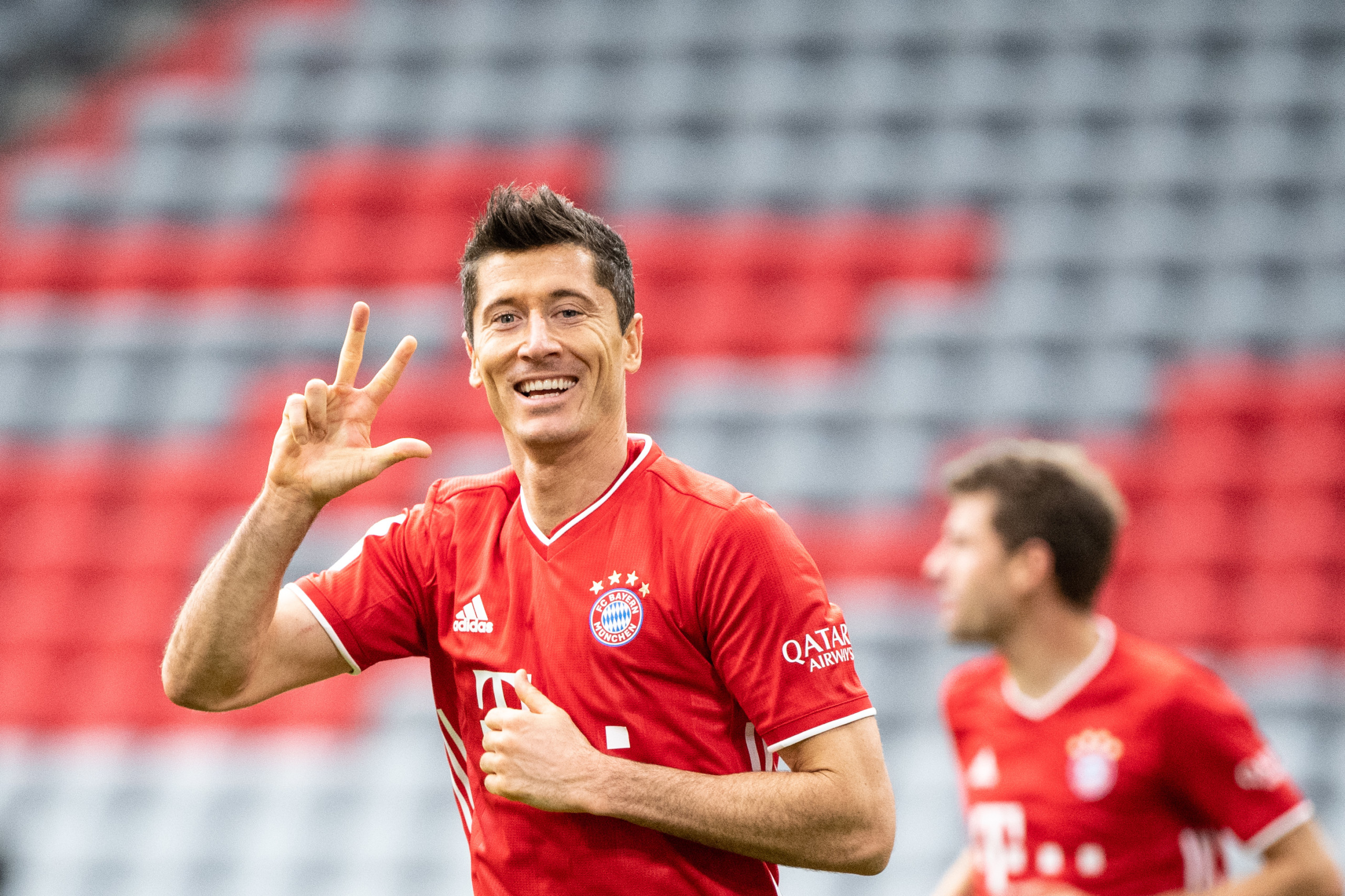Vitesse Arnhem has signed up for a partnership with StatsBomb to use their industry-leading football data. The collaboration with the fast-growing company highlights the Eredivisie team's commitment to innovation and will see Vitesse Arnhem reap the benefits of Statsbomb’s data and IQ software platforms to enhance talent identification, performance analysis and opposition scouting. Vitesse Arnhem joins around 100 professional clubs and federations worldwide in using StatsBomb's deep data, covering over 3,400 events per game. The data includes unique metrics such as Pressures by Player and Team, Pass Footedness, Pass Height, Freeze Frame for Shots and On-Ball Value - the company's new possession value model. Alexandre Taylor, Sales Executive, StatsBomb, said: "We are excited to start working with Vitesse Arnhem, a club at the forefront of football data innovation. We are looking forward to a successful partnership contributing to the club’s data-driven strategy, where our data will help inform critical decisions around recruitment and scouting.” Speaking about the partnership, Johannes Spors, Sporting Director, Vitesse, said: "At Vitesse, we are constantly looking for smart and inventive solutions. We welcome new ideas, embrace modern technologies and love different ways of thinking. For our scouting and analysis, the focus on video and data-driven elements is therefore becoming increasingly important. COVID-19 and its travel restrictions have made these tools even more valuable. The addition of StatsBomb as a data service fits seamlessly into our innovative approach and helps us to scout and develop high potential talents from Europe and make targeted match analyses." About StatsBomb StatsBomb is the world’s fastest growing football data company. Founded by former analyst Ted Knutson, StatsBomb was formed to empower data analysis teams by ensuring they have access to the best football data set ever created. Having started as an analytics blog, StatsBomb initially progressed to consulting on data-driven recruitment and performance analysis for professional teams. In 2018, having become frustrated with limitations of the data available at the time, StatsBomb acquired ArqamFC, a data collection company based in Cairo, Egypt, and started to collect and supply its own data. The introduction of StatsBomb data was a turning point for the analysis of football as it introduced previously unavailable metrics such as pressures, the height of the ball at the point of shot impact, goalkeeper positioning, freeze frames for shots and the foot with which each pass is played. In 2021, StatsBomb improved this data even further with the launch of StatsBomb 360, adding a snapshot of all visible player locations to more than 3,400 on-the-ball events that are collected per match. Having gained rapid traction since its inception, StatsBomb is now servicing customers across the professional game, as well as betting and gaming operators, and is active in over 20 countries.
Author: admin
What Happened At The 2021 StatsBomb Conference
The StatsBomb Conference made a long-awaited return to Stamford Bridge last week. We welcomed various individuals from across the sports analytics sphere for a day of industry-leading talks, data-driven research and unique networking opportunities. In 2019, we couldn't have imagined that it would have taken almost two years to get everyone back together, but we’re delighted with the turnout this year. Let's look back at the key things that happened to give those who attended a chance to revisit their experience and those who missed it an opportunity to catch up on the day. Industry-Leading Talks Before the guest presenters took to the stage, StatsBomb CEO Ted Knutson kicked things off with an opening talk about the company's progression since the last conference and our fast-approaching expansion into American Football. The day continued with Dr Ian Graham (Liverpool), Harry Moyal (Olympique Lyonnais), Devin Pleuler (Toronto FC), Vosse de Boode (AFC Ajax) and Mladen Sormaz (Leicester City) all delivering expert presentations on the Main Stage. Each speaker drew on key insights to discuss various topics within their organisations, from measuring playing styles in different competitions to implementing data-driven recruitment strategies. 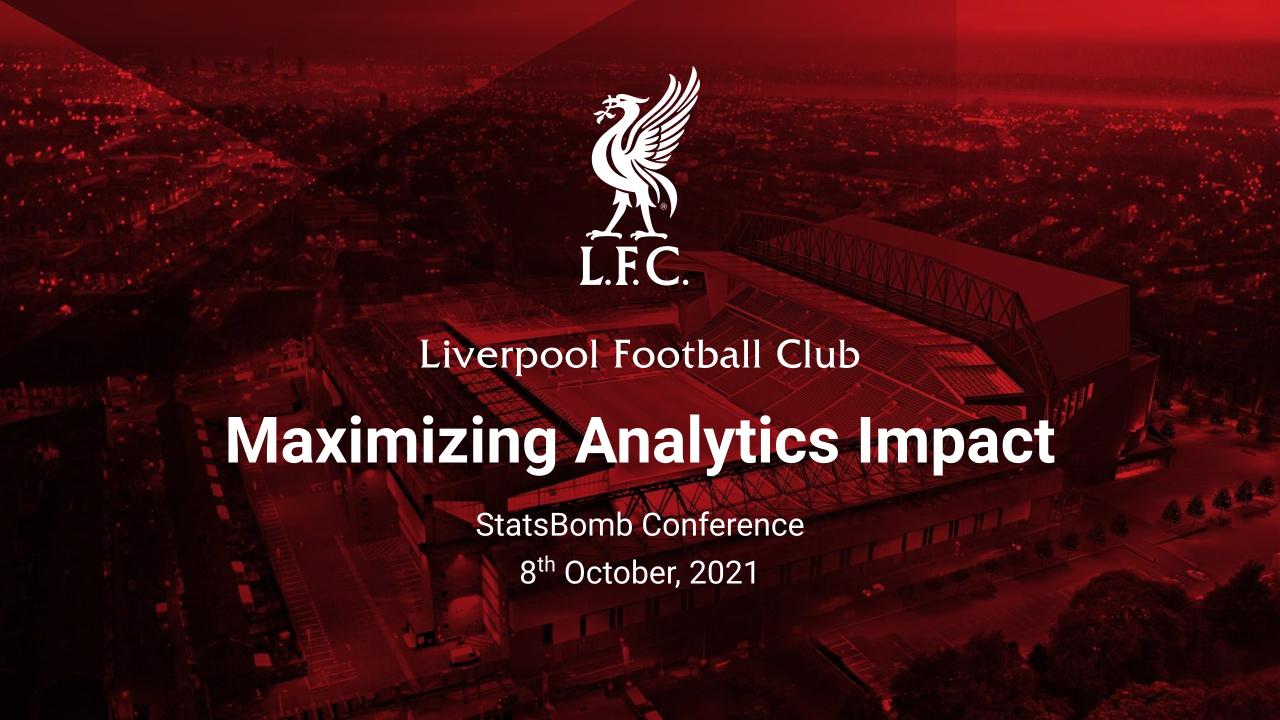 The Directors of Football Panel featured StatsBomb's James Yorke in conversation with Victor Orta (Leeds United), James Cryne (Barnsley FC) and Will Kuntz (Los Angeles FC). The panellists spoke in-depth about successfully implementing data-driven methods around player recruitment, opposition analysis, and general strategy within their respective clubs. Ted Knutson and Daryl Morey (Philadelphia 76ers) closed the Main Stage and indeed the entire Conference in their fireside chat, with a collection of insightful stories from their respective sports and discussions around the role of data and analytics in basketball and football. Innovation in Football Analytics The Harris Suite featured a variety of hand-picked presenters giving attendees an exclusive window into the current state of play surrounding innovative research in football analytics. The nature of the papers covered a variety of topics, including driving goalkeeper decisions, identifying high pressing styles and penetrative passes. These talks contained the first sets of publicly-available research performed on StatsBomb 360 data.
The Directors of Football Panel featured StatsBomb's James Yorke in conversation with Victor Orta (Leeds United), James Cryne (Barnsley FC) and Will Kuntz (Los Angeles FC). The panellists spoke in-depth about successfully implementing data-driven methods around player recruitment, opposition analysis, and general strategy within their respective clubs. Ted Knutson and Daryl Morey (Philadelphia 76ers) closed the Main Stage and indeed the entire Conference in their fireside chat, with a collection of insightful stories from their respective sports and discussions around the role of data and analytics in basketball and football. Innovation in Football Analytics The Harris Suite featured a variety of hand-picked presenters giving attendees an exclusive window into the current state of play surrounding innovative research in football analytics. The nature of the papers covered a variety of topics, including driving goalkeeper decisions, identifying high pressing styles and penetrative passes. These talks contained the first sets of publicly-available research performed on StatsBomb 360 data. 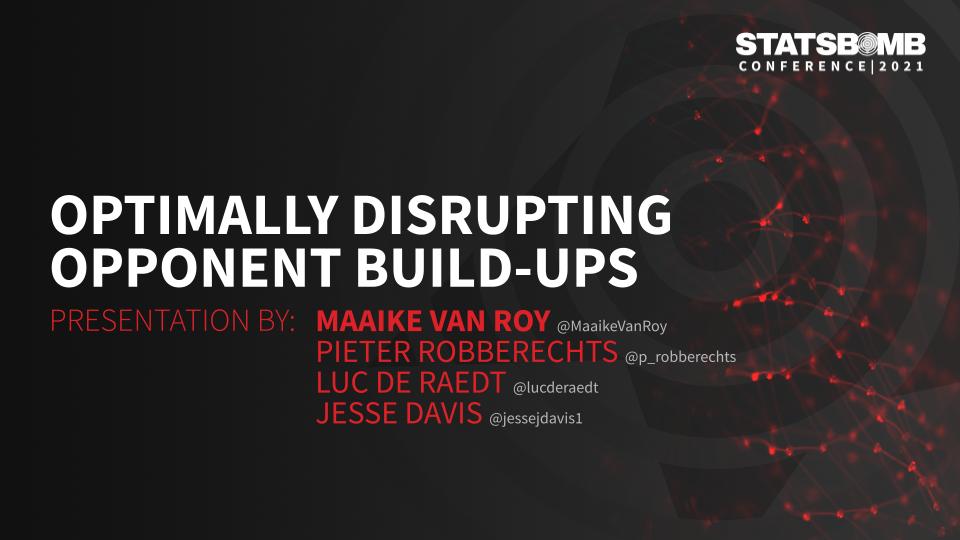 Each researcher created their specific papers using StatsBomb data and tuned in from different locations across the globe to deliver their novel research to our attendees. It was a fascinating experience to see the different approaches taken by each speaker across each of their papers. We will release all of the research papers in the coming weeks, and you will be able to see the latest developments and research in the football analytics landscape. StatsBomb 2021 Conference: A Welcome Return One of the main pieces of feedback from the day was how great it was to get everyone from the industry back in a room again to connect and learn from each other. We hope you enjoyed the day surrounded by your friends and peers, learning from some of the best in the industry. Here are a few snapshots from conference attendees about their experiences last week.
Each researcher created their specific papers using StatsBomb data and tuned in from different locations across the globe to deliver their novel research to our attendees. It was a fascinating experience to see the different approaches taken by each speaker across each of their papers. We will release all of the research papers in the coming weeks, and you will be able to see the latest developments and research in the football analytics landscape. StatsBomb 2021 Conference: A Welcome Return One of the main pieces of feedback from the day was how great it was to get everyone from the industry back in a room again to connect and learn from each other. We hope you enjoyed the day surrounded by your friends and peers, learning from some of the best in the industry. Here are a few snapshots from conference attendees about their experiences last week.
Great #StatsBombConference at #StamfordBridge. Outstanding lineup and organization. New approaches on football analytics and good conversations. @StatsBomb @StatsBombES ⚽️ pic.twitter.com/ij4RIum7gC
— Mikel Gandarias (@MikelGandarias) October 8, 2021
Great morning at #statsbombconference , love seeing how far @StatsBomb have come, and excited about where they are going. Nice talk from @mixedknuts, then Ian Graham with maybe my favourite ever analytics conference talk. https://t.co/72TDEen4BJ
— Ian Lynam (@ianlynam) October 8, 2021
You can see more of what attendees thought of our event by searching on the #StatsBombConference hashtag on your chosen social media platforms. What Next? If you missed any of the talks at our 2021 Conference, keep an eye on our Twitter and LinkedIn in the coming weeks. We will be releasing some of the talks, recorded presentations, and papers from the research track. In the meantime, you can check out Tom Worville's key insights from the 2021 Conference or listen to his notable takeaways on The Athletic Football Tactics Podcast. Or you can check out David Álvarez writing for EL PAÍS with a selection of quotes from several talks. We look forward to seeing you all again at our StatsBomb Conference 2022, but until then, keep an eye out for other StatsBomb events next year!
StatsBomb Live Online Launch Event Set for August 12th
The eagerly anticipated, StatsBomb Live data set is about to launch. Engineered by the same experts, with the same commitment to accuracy and quality, StatsBomb Live brings the best of StatsBomb, but now in a real-time format. Save the date for August 12th, where you can expect a first look at the exciting features that make up this game-changing new product. The online event will cover:
- Exclusive insight as to how StatsBomb Live was designed and created, keeping customer feedback central to decision making processes
- Meet the team who brought the StatsBomb Live product to life and hear about how they have tackled the challenge of balancing speed with quality in a real-time environment
- Sneak peaks as to how StatsBomb Live clients will be able to access, analyse and visualise this exciting new data set
This completely unique product offering is perfect for those who need to analyse the highest quality football data, in real-time. Be sure to tune in to see how StatsBomb Live can work for digital media, broadcasting, betting and gaming and professional football. Join StatsBomb's co-founder and COO, Charlotte Randall and many other key members of the StatsBomb Live team on August 12th to find out more. Everyone is welcome, all you need to do to register for this free online event is sign up here. We can't wait to see you! And to book in for your free StatsBomb Live demo, please contact: sales@statsbomb.com
StatsBomb CEO Update, May 2021
Marketing has been bugging me to write something about the company as a whole, and given we’re approaching summer already, I guess it’s time to update people on StatsBomb’s progress. First things first… We are hiring. I know it seems like we post things on social media about hiring a lot, and that is because we are almost always hiring new people. That’s what happens when companies triple in size every year like we have. We’re a great place to work, sitting at the intersection of sports*, data, and technology. We’re also flexible around working arrangements and qualifications for talented people. Join us! https://statsbomb.com/careers/ * Multiple sports. Soccer/football + American Football this year. Next year…? StatsBomb Conference 2021  I teased the tiniest bit of info around this in the last week, but now I will reveal a bit more… Our conference is one of my favourite things in the entire calendar. (And I'm not just saying that because it falls near my birthday.) Feedback on our first conference in 2019 was that it was one of the best conferences people had ever attended. Credit for that goes to a lot of people - from the organisers in our team, to the A/V people who broadcast it to the world, and especially to the speakers who unequivocally brought their ‘A’ games to the stage. As it’s a StatsBomb conference, the focus remains on research and ideas people are excited about, which we think is a formula that yields great presentations. Concrete details on the confirmed speaker lineup will appear on social media in the coming weeks, but they already include:
I teased the tiniest bit of info around this in the last week, but now I will reveal a bit more… Our conference is one of my favourite things in the entire calendar. (And I'm not just saying that because it falls near my birthday.) Feedback on our first conference in 2019 was that it was one of the best conferences people had ever attended. Credit for that goes to a lot of people - from the organisers in our team, to the A/V people who broadcast it to the world, and especially to the speakers who unequivocally brought their ‘A’ games to the stage. As it’s a StatsBomb conference, the focus remains on research and ideas people are excited about, which we think is a formula that yields great presentations. Concrete details on the confirmed speaker lineup will appear on social media in the coming weeks, but they already include:
- A sitting General Manager of an NBA team
- Director of Research at a League - and Champions League - winning club.
There are also at least four other analytics people at Champions League level clubs making sure they have permission to speak at the event before we confirm them, but I’m extremely excited about October already. Research Data Another reason for excitement will be the data that is on offer for participants in the research paper competition. We’re going to offer two different options:
- 190 games of StatsBomb Data AND StatsBomb 360 Data from the 2020-21 German Bundesliga or Spain’s La Liga. (It will be all league matches for the top 10 teams in either league.)
- A smaller subset of games (40-60) of StatsBomb base Data, 360, AND tracking data from REDACTED.
More details about the research paper contest will be released in June, but this should be enough info to get the ideas flowing. Tickets Unlike a conference like Sloan where thousands of people attend every year, our event is not huge. We’ll have the following ticket allocations:
- 300-350 General Admission at £250 + VAT
- 50-100 Student tickets at 50% discount
There will also be customer tickets (allocated first), and staff/speaker tickets as well. The wiggle in student allocations is largely around vaccine timelines for that group. I just wanted to let everyone know what the structure will look like ahead of time, so you can be prepared when we start announcing ticket sales on social media. NOTE: There is extreme complexity around vaccinations, venue restrictions, and international travel right now. We are doing our best to navigate this in a sensible way, but obviously most of these elements are also not within our control. Our mandate is to provide a safe, happy environment for attendees to enjoy. Streaming Part of the conference will be broadcast live. Most of the talks will also be released on YouTube in the weeks after the event completes. All of the research papers will be published to the world. If you want more details, you’ll need to wait until October. Sponsors We will also be selling a small allocation of external sponsor slots to interested companies. Contact conference@statsbomb.com for more details. 360 Data 360 Data for the 2020-21 Premier League season will be done this week. La Liga is scheduled to finish a week later, and the rest of the Big 5 will complete in June. Expect to see more visualisations and analysis from us on the new data set as we begin to wrap our heads around what is possible (and useful) in contextual event data. This data set is so cool, and our entire team is excited to have access to multiple full seasons now and see what we can do. Live  The Live Data event launch is booked for August 12th. It will happen online, so no need to worry about tickets for that. We have some partnership work with current customers happening in the meantime, but by August we’ll have a fantastic visual, interactive product to display along with the exceptional data. If you are a team or business interested in obtaining our Live data before the new season begins, send an email to ted@statsbomb.com and I will personally route you to the correct person. Set Pieces There is a shortage of qualified, smart set piece coaches in the world. USMNT head coach Gregg Berhalter mentioned as much during our panel at Sloan this year. Our online Set Pieces course will once again be made available in early July. It will be made available for online purchase for one month and then it will disappear into the ether once more, possibly for good. I’m likely to go back to only teaching this course in person, or via agreements with certain FAs. Don't complain to me about the price we charge. I actively recommend talented people for set piece roles across football multiple times a month right now. Every PL team will have a slot for this type of coach/analyst soon and they will make six figures a year because they help teams score goals. Eventually the best set piece people will be fought over like the best head coaches are right now. Do the work, and the jobs will be waiting for you. Continued Thank Yous Collecting great data is hard. Even if you get every detail on 99% of events correct, with 3,400 events per match, that still means there are 34 that aren’t quite right. Feedback from our customers and fans helps fill that remaining gap, and we’re glad you are as passionate about seeing perfect data on your favourite teams on FBRef as we are about producing it. As a company we have been very lucky to not only survive, but to continue growing through the COVID-19 pandemic. Revenue was up nearly 25% in the first quarter of 2021 alone, and we added so many new customers that we now need to hire more people to support them. This is very much a virtuous cycle, and it would not have happened without belief and support from our customers, and also the fans that have supported the blog and now the company. Enjoy your summer, everyone. And especially… enjoy the Euros. Ted Knutson CEO, StatsBomb @mixedknuts Ted@statsbomb.com
The Live Data event launch is booked for August 12th. It will happen online, so no need to worry about tickets for that. We have some partnership work with current customers happening in the meantime, but by August we’ll have a fantastic visual, interactive product to display along with the exceptional data. If you are a team or business interested in obtaining our Live data before the new season begins, send an email to ted@statsbomb.com and I will personally route you to the correct person. Set Pieces There is a shortage of qualified, smart set piece coaches in the world. USMNT head coach Gregg Berhalter mentioned as much during our panel at Sloan this year. Our online Set Pieces course will once again be made available in early July. It will be made available for online purchase for one month and then it will disappear into the ether once more, possibly for good. I’m likely to go back to only teaching this course in person, or via agreements with certain FAs. Don't complain to me about the price we charge. I actively recommend talented people for set piece roles across football multiple times a month right now. Every PL team will have a slot for this type of coach/analyst soon and they will make six figures a year because they help teams score goals. Eventually the best set piece people will be fought over like the best head coaches are right now. Do the work, and the jobs will be waiting for you. Continued Thank Yous Collecting great data is hard. Even if you get every detail on 99% of events correct, with 3,400 events per match, that still means there are 34 that aren’t quite right. Feedback from our customers and fans helps fill that remaining gap, and we’re glad you are as passionate about seeing perfect data on your favourite teams on FBRef as we are about producing it. As a company we have been very lucky to not only survive, but to continue growing through the COVID-19 pandemic. Revenue was up nearly 25% in the first quarter of 2021 alone, and we added so many new customers that we now need to hire more people to support them. This is very much a virtuous cycle, and it would not have happened without belief and support from our customers, and also the fans that have supported the blog and now the company. Enjoy your summer, everyone. And especially… enjoy the Euros. Ted Knutson CEO, StatsBomb @mixedknuts Ted@statsbomb.com
StatsBomb enter a new market by partnering with UDN Sports of Japan
One of Japan’s most prestigious player agencies, UDN Sports, has signed a partnership with StatsBomb to access insights from StatsBomb’s industry leading football data set. This is the first entry into the Japanese market for StatsBomb, one of the fastest growing sports data companies in the world. UDN Sports, based in Tokyo, represents more than 100 professional players in Europe and Japan, including current Japanese internationals Shinji Kagawa, Takehiro Tomiyasu and Yui Hasegawa. The partnership will see UDN Sports benefit from StatsBomb’s cutting edge data covering over 3,400 events per match across more than 80 competitions around the globe. The agency will also gain access to StatsBomb IQ, the most advanced and customisable football analytics platform available. UDN Sports joins over 100 professional clubs, federations, agencies and media outlets around the world in choosing StatsBomb data to enhance their ability to make well-informed decisions. UDN Sports Agent, Kunihiro Fujita, said: “We are grateful for the opportunity to enter into a partnership with StatsBomb, one of the world's leading data collection and analysis companies when it comes to thinking about improving the performance of Japanese players. In recent years, we have seen a rapid increase in adopting data as a tool in sport, and we expect that the data collection and analysis not only on a team basis but also on an individual player's basis, will become an even more important factor. We believe that utilizing StatsBomb data will help to improve the performance of individual players and contribute to the development of the Japanese football.” StatsBomb’s Business Development Lead, Ismail Tari, said: “It is great to be working with Japan’s most renowned sports agency UDN Sports. Throughout our conversations, the UDN team has shown fantastic ambition and understanding of the role our data and IQ platform will play in the future development of Japanese football and its media. We’re delighted to be expanding into Japan and are looking forward to many great projects together.” Ted Knutson, StatsBomb Co-Founder and CEO added: "It's great for StatsBomb to be working with UDN Sports and for our industry-leading data to have an influence in Japan and beyond. This is another good example of how StatsBomb can work with player agencies as well as clubs and federations across the world. Our recent expansions into Brazil, Mexico and South Africa have been really exciting and we are looking forward to seeing more growth in Japan and Asia now too." About StatsBomb StatsBomb is the world’s fastest growing football data company. Founded by former analyst Ted Knutson, StatsBomb was formed to empower data analysis teams by ensuring they have access to the best football data set ever created. Having started as an analytics blog, StatsBomb initially progressed to consulting on data-driven recruitment and performance analysis for professional teams. In 2018, having become frustrated with limitations of the data available at the time, StatsBomb acquired ArqamFC, a data collection company based in Cairo, Egypt, and started to collect and supply its own data. The introduction of StatsBomb data was a turning point for the analysis of football as it introduced previously unavailable metrics such as pressures, the height of the ball at the point of shot impact, goalkeeper positioning, freeze frames for shots and the foot with which each pass is played. In 2021, StatsBomb improved this data even further with the launch of StatsBomb 360, adding a snapshot of all visible player locations to more than 3,400 on-the-ball events that are collected per match. Having gained rapid traction since its inception, StatsBomb is now servicing customers across the professional game, as well as betting and gaming operators, and is active in over 20 countries.
StatsBomb’s global growth continues with ground-breaking partnership with Clube Atlético Mineiro in Brazil
One of Brazil’s biggest football clubs, Clube Atlético Mineiro, have signed a partnership with StatsBomb, empowering their analytics department, led by Rodrigo Picchioni and Pedro Picchioni, with the most detailed football data available. This is the first time StatsBomb, one of the fastest growing sports data companies in the world has expanded its marketing-leading services into Brazil.
The partnership will see Clube Atlético Mineiro receive StatsBomb’s cutting edge data covering over 3,400 events per match, across dozens of leagues and competitions across the globe. Alongside the data, the club will have full access to StatsBomb IQ, the most advanced and customisable football analytics platform available.
Clube Atlético Mineiro join around 100 professional clubs and federations around the world in enhancing their ability to scout and recruit players, analyse upcoming opponents and evaluate team performance.
Plínio Signorini, CEO, Clube Atletico Mineiro said:
"Clube Atlético Mineiro has chosen the best data provider in the world to start its analytics department. One of the strategic principles of our club is, after all, to be a reference in Latin America both on and off the pitch. In order to achieve that, it is crucial to seek innovative and efficient partners such as StatsBomb."
StatsBomb’s Head of Tactical Innovation and Business Development, Pablo Peña Rodríguez said:
"It is great to be working with one of the biggest clubs in Brazil. Throughout our conversations, the analytics team at Atletico Mineiro have shown fantastic ambition and understanding of the role our data and IQ platform can play in their preparations. We’re delighted to be expanding into Brazil and are looking forward to more opportunities in the region."
La Liga 2020/21 Mid-Season Review
We continue our tour through the major European leagues with a look at the season to date in La Liga, the most goal and shot shy of the big five leagues but one that nevertheless features some intriguing storylines, including a runaway leader, tactical adjustments and some standout individuals.
Atlético Madrid, Runaway Leaders
In the last 16 seasons, Atlético Madrid are the only side other than Barcelona and Real Madrid to have won La Liga, and they may just be on course to do so again. Diego Simeone’s side are 10 points clear at the top, and also have a game in hand over those two sides. Fifty points from 19 matches has them on course to equal the league’s highest-ever points total of 100 if they are able to maintain that rhythm. The likelihood is that they won’t. No side have overperformed their metrics to a greater extent than Atlético so far this season. They are running ahead of expectation at both ends of the pitch, but particularly so in attack, where they are around 13 goals ahead of their xG. 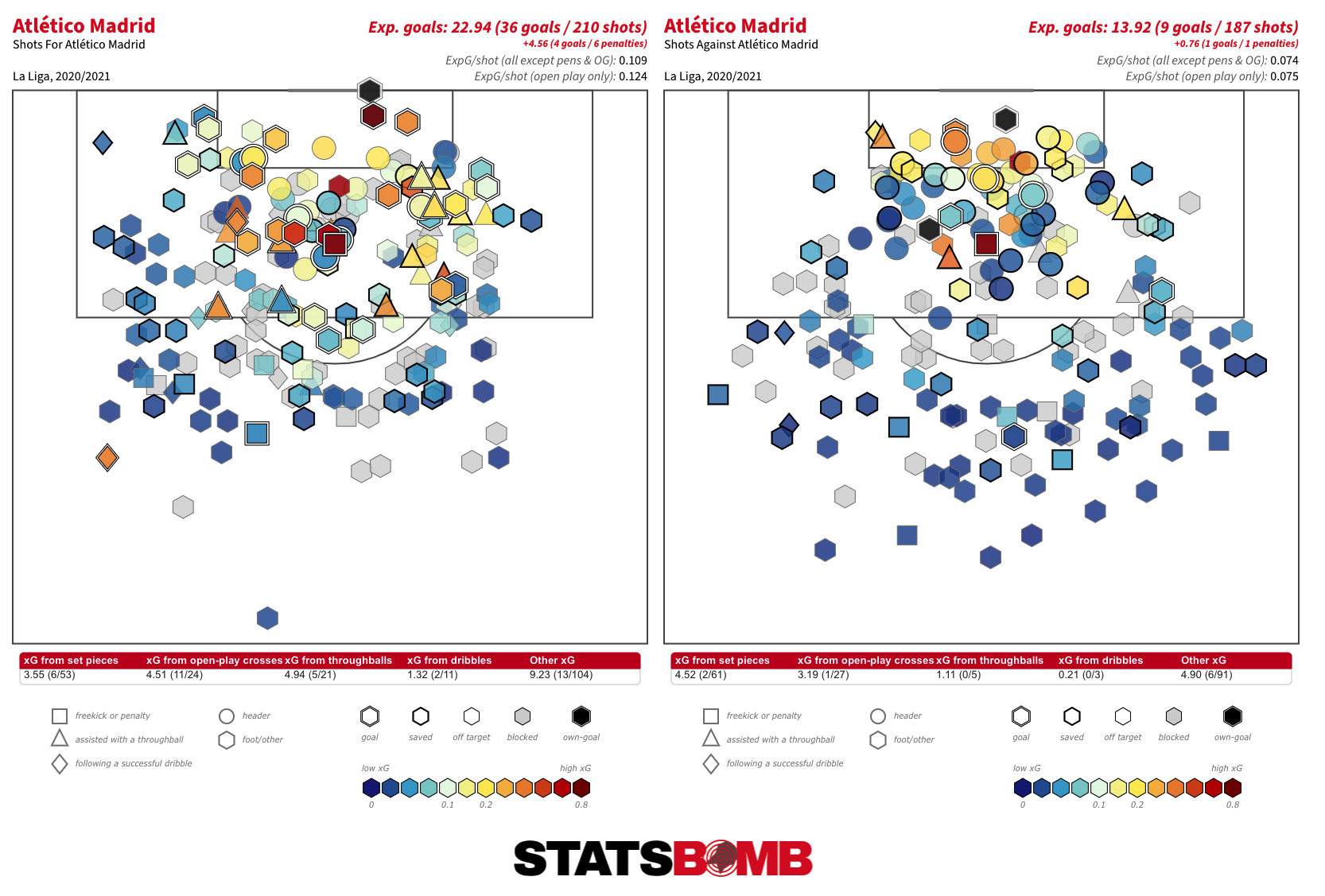 It is almost the exact opposite to what happened to them last season, when all their forwards were underperforming their xG at this stage of the campaign. This time around, everyone is overperforming: Luis Suárez, Marcos Llorente, João Félix, Ángel Correa, even Yannick Carrasco. That is likely to even out a bit from hereon out, but Atlético can still count upon a goalkeeper who has consistently shown his value by overperforming his metrics. On both an outright and shot-volume-adjusted basis, Jan Oblak has been the league’s best shot stopper this season.
It is almost the exact opposite to what happened to them last season, when all their forwards were underperforming their xG at this stage of the campaign. This time around, everyone is overperforming: Luis Suárez, Marcos Llorente, João Félix, Ángel Correa, even Yannick Carrasco. That is likely to even out a bit from hereon out, but Atlético can still count upon a goalkeeper who has consistently shown his value by overperforming his metrics. On both an outright and shot-volume-adjusted basis, Jan Oblak has been the league’s best shot stopper this season. 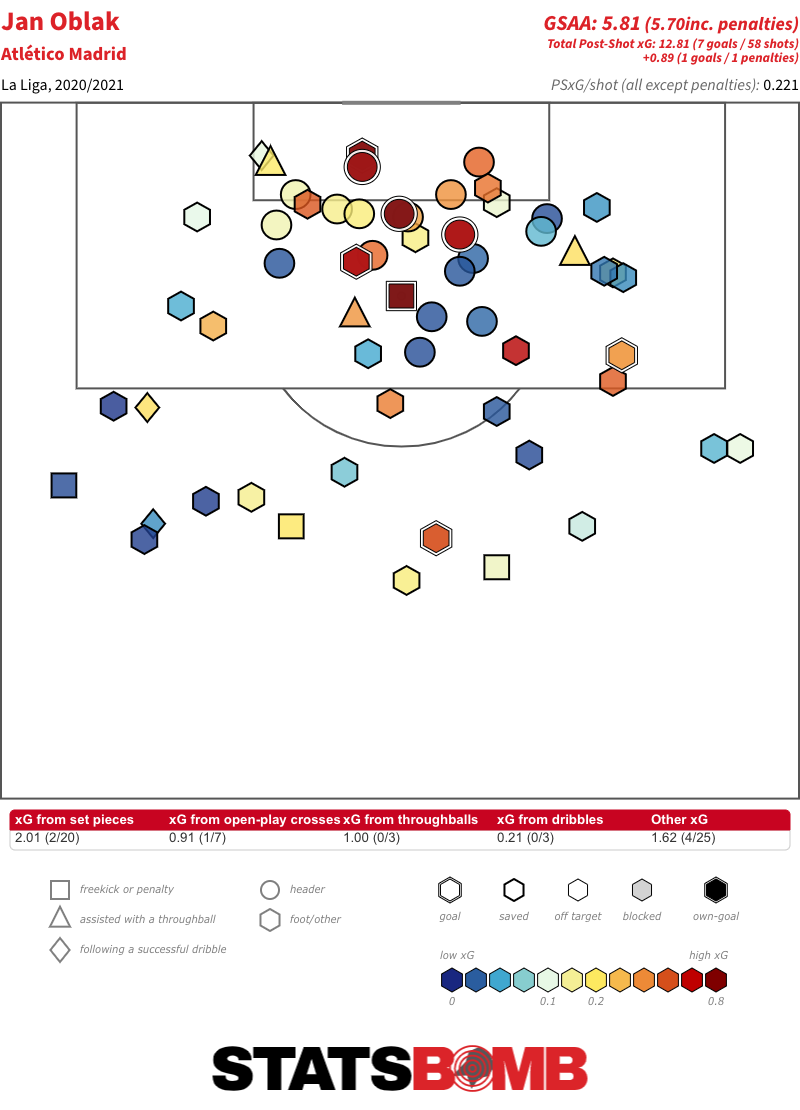 Even if Atlético’s points accumulation rate does slow somewhat during the second half of the campaign, they probably have enough of a cushion to absorb that and still end up lifting the trophy. Barcelona seem to be finding their feet after a shaky start, at least in terms of results, under Ronald Koeman, and do have the best underlying numbers in the league...
Even if Atlético’s points accumulation rate does slow somewhat during the second half of the campaign, they probably have enough of a cushion to absorb that and still end up lifting the trophy. Barcelona seem to be finding their feet after a shaky start, at least in terms of results, under Ronald Koeman, and do have the best underlying numbers in the league... 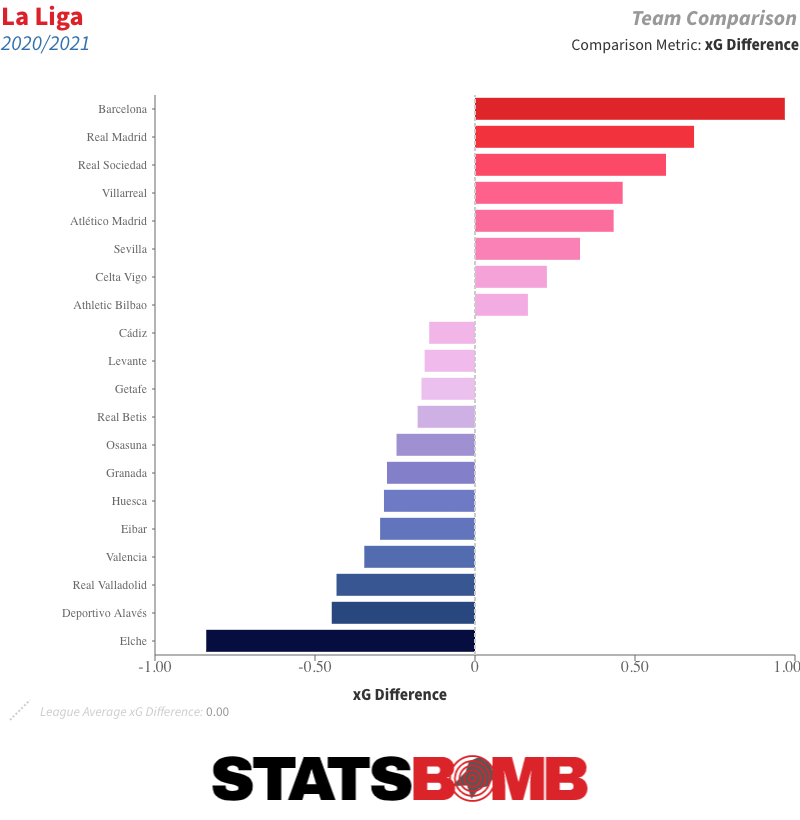 ...but they would have to maintain an extremely strong pace to chase Atlético down from here. Real Madrid likewise have better metrics than the current leaders, but have struggled for consistency. The league looks to be Atlético’s to lose.
...but they would have to maintain an extremely strong pace to chase Atlético down from here. Real Madrid likewise have better metrics than the current leaders, but have struggled for consistency. The league looks to be Atlético’s to lose.
Pressing Matters
One of the most obvious changes upon Koeman’s arrival to the Barcelona bench was that they immediately began to contest possession less frequently, particularly high up the pitch. Whether by PPDA (Passes per Defensive Action) or Aggression (the percentage of opposition ball receipts that are contested within two seconds), they were one of most passive teams in the league through the first few months of the season. 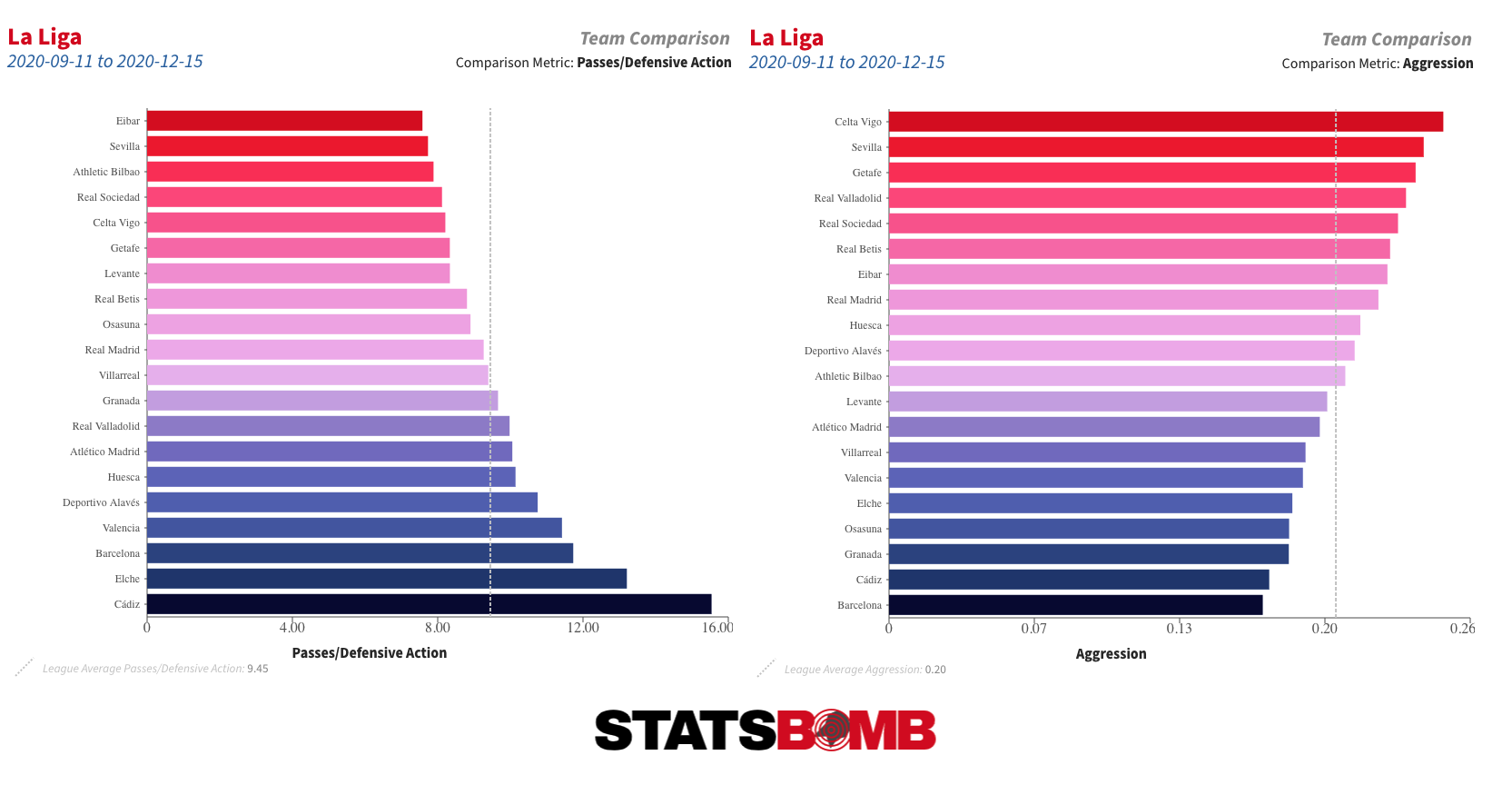 In fact, by the former measure, Barcelona were more passive than they’d been at any previous stage in our dataset, which extends back to 2004, in those first 10 or 11 matches under Koeman. But since then, there does seem to have been a shift towards a slightly more proactive setup, more in line with what we saw at times under Ernesto Valverde.
In fact, by the former measure, Barcelona were more passive than they’d been at any previous stage in our dataset, which extends back to 2004, in those first 10 or 11 matches under Koeman. But since then, there does seem to have been a shift towards a slightly more proactive setup, more in line with what we saw at times under Ernesto Valverde. 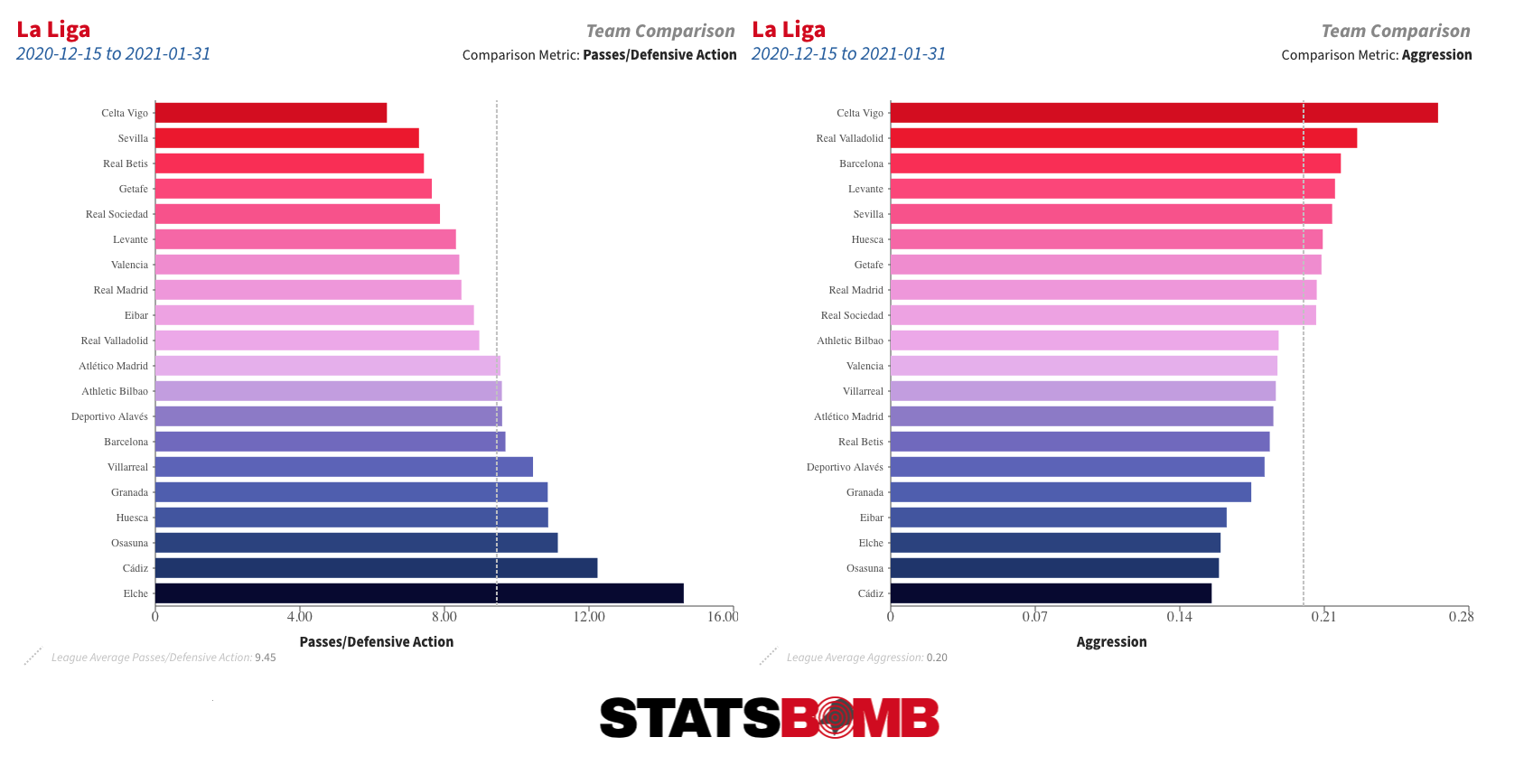 Some of that could simply be due to the natural ebb and flow of the season. Barcelona had midweek Champions League engagements through much of the opening three months of the campaign, perhaps necessitating a less energy intensive approach. We’ll have to wait for a larger sample to see if this apparent shift holds through the remainder of the campaign. At the opposite end of the scale sit a Celta Vigo side who have become notably more proactive without the ball this season, and particularly so since Eduardo Coudet replaced Óscar García as head coach in November. They have pushed their defensive line up and are logging a higher Aggression percentage than any other side in the league.
Some of that could simply be due to the natural ebb and flow of the season. Barcelona had midweek Champions League engagements through much of the opening three months of the campaign, perhaps necessitating a less energy intensive approach. We’ll have to wait for a larger sample to see if this apparent shift holds through the remainder of the campaign. At the opposite end of the scale sit a Celta Vigo side who have become notably more proactive without the ball this season, and particularly so since Eduardo Coudet replaced Óscar García as head coach in November. They have pushed their defensive line up and are logging a higher Aggression percentage than any other side in the league.
Relentlessly Positive Ontiveros
Huesca have been in the bottom three since the seventh matchday, but things are so tight down there, with just four points spanning the bottom six, that they still have a decent chance of scrambling clear of the relegation zone. If they are to do so than Javi Ontiveros is likely to have a big role to play. Whether from the start or the bench, he is an intensely positive player who seems not to understand the idea of a backwards step. Whether on the pass or the carry, he is a relentless ball progressor... 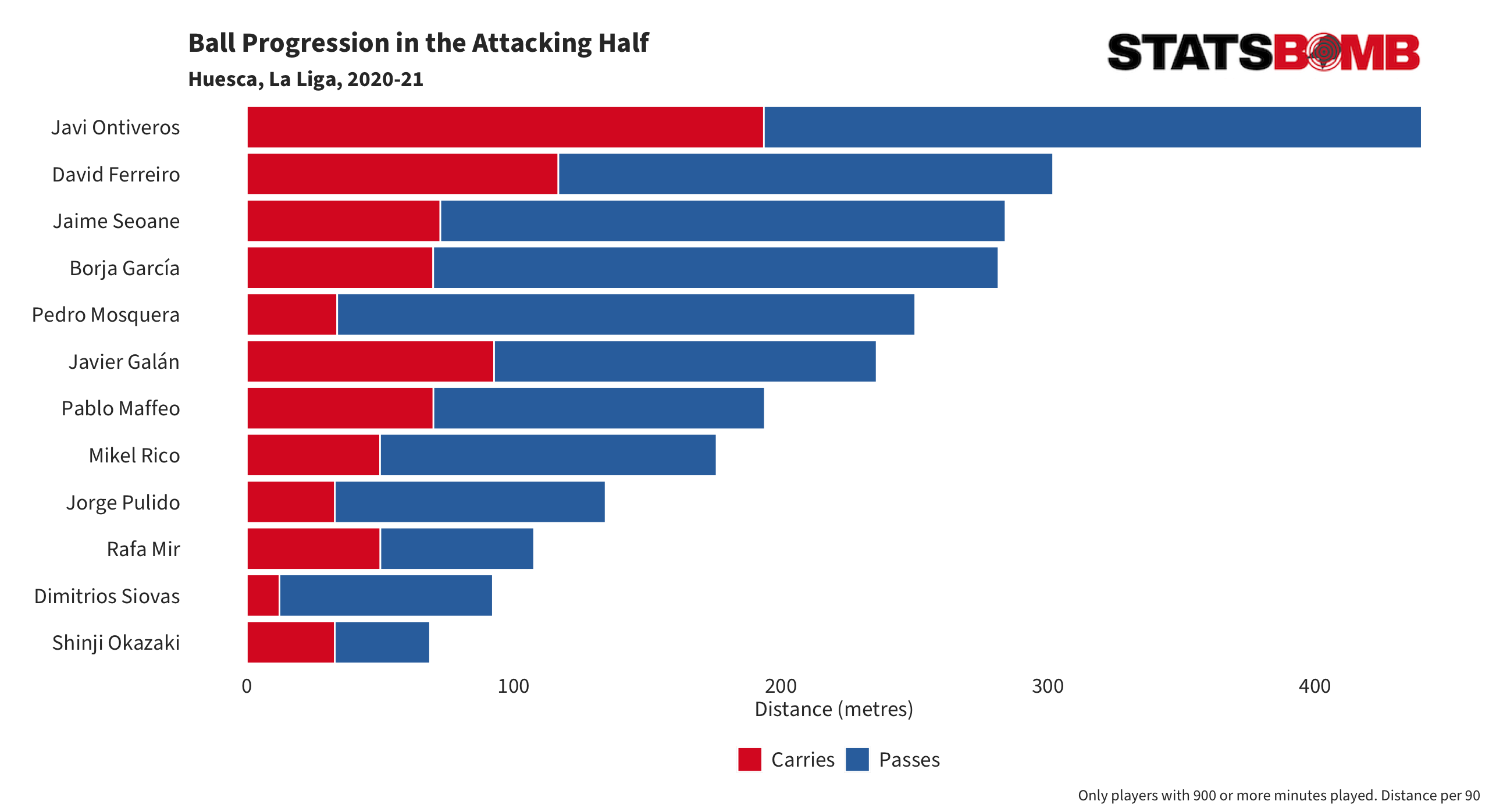 ...and while his shooting locations bring to mind Spurs-era Andros Townsend...
...and while his shooting locations bring to mind Spurs-era Andros Townsend... 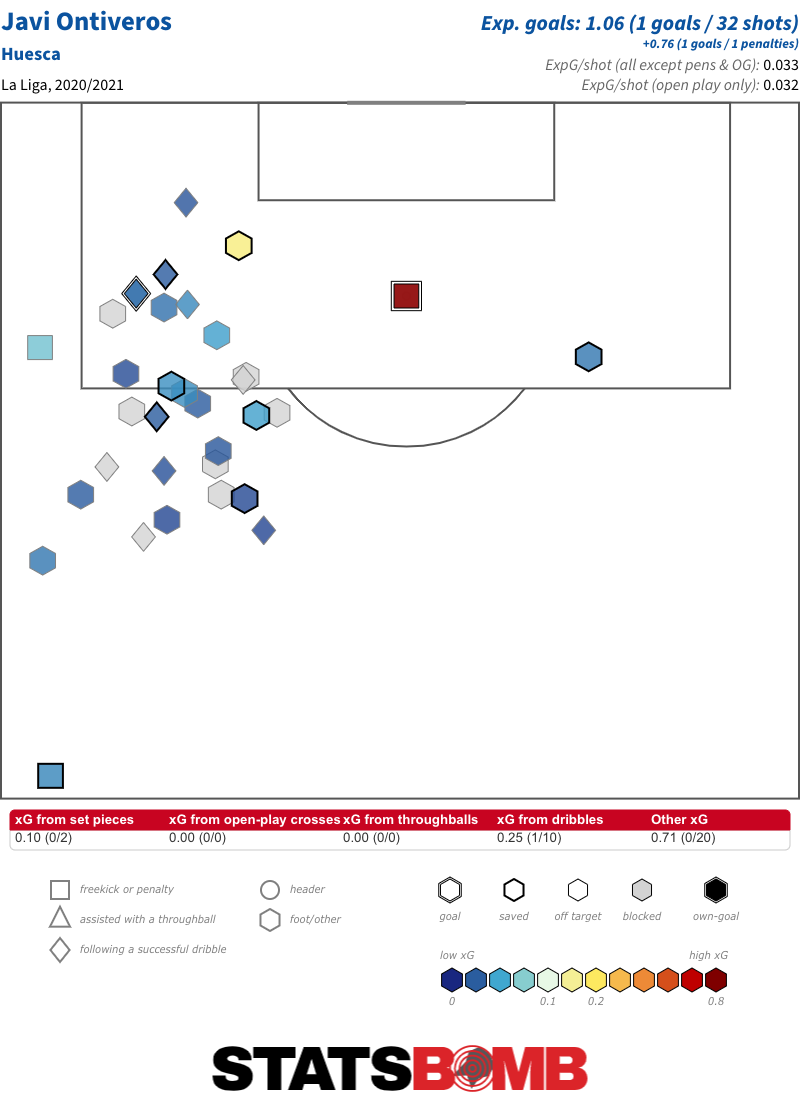 ...he is such an entertaining watch that you can almost forgive him. Not only does he produce far more shots per 90 after carries of 10 metres or more (1.47) than any other player in the league, but he also leads it in nutmegs per 90 (ahead of Alberto Perea and Bryan Gil) and ranks in the top three for successful dribbles. Ontiveros is the guy to inject a bit of fun into your viewing of La Liga.
...he is such an entertaining watch that you can almost forgive him. Not only does he produce far more shots per 90 after carries of 10 metres or more (1.47) than any other player in the league, but he also leads it in nutmegs per 90 (ahead of Alberto Perea and Bryan Gil) and ranks in the top three for successful dribbles. Ontiveros is the guy to inject a bit of fun into your viewing of La Liga.
Additional tidbits
- Nabil Fekir of Real Betis has taken more shots than any other player in the big five leagues this season without scoring: 53. He’s also only converted one of his three penalties.
- One of the many advantages of the StatsBomb dataset is that we record the foot with which each pass is played. That allows us to see that for the second season in a row, Tomás Pina of Alavés is the most two-footed player in La Liga. Last season, he played an exact 50-50 split of passes with each foot. This time he’s slightly favoured the left in a 51-49 split. Pedro Bigas has consistently been one of the league's most two-footed players through his time with Las Palmas and now Eibar, and he is again there at Pina’s side.
Join us at StatsBomb Evolve on March 17th 2021 to discover how we are revolutionising the football data industry (once again), including the launch of our new data product, StatsBomb 360. 
The Players to Watch in the Copa Libertadores Final
Palmeiras and Santos meet in the famous Maracaña stadium in Rio de Janeiro on Saturday in the final of the Copa Libertadores. The two Brazilian teams, both from São Paulo, have a number of interesting players, and here are some to watch out for in the final of South America’s primary club competition.
Rony, Palmeiras
Rony has been Palmeiras’ most productive attacker in their Libertadores campaign, scoring five goals (including one penalty) and providing seven assists. Abel Ferreira’s team take full advantage of opportunities to attack in transition and Rony, fast and direct in all of his actions, plays a key role in the final stages of those attacks. 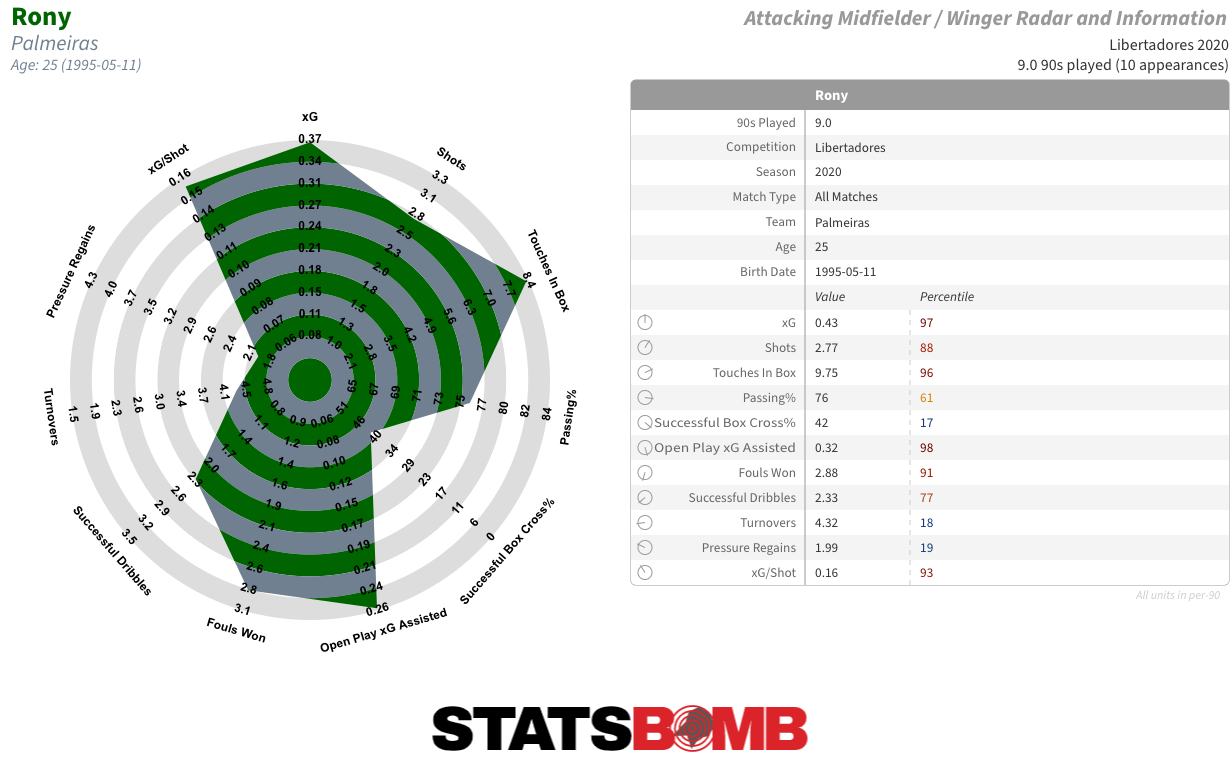 The 25-year-old stood out at Athletico Paranaense last season for the quantity of shots he both created and took, and he has repeated that production at Palmeiras. Not only that, but he has significantly improved his shot locations, taking fewer long-range efforts and more from inside the six-yard box, while also benefiting from an increased throughball supply.
The 25-year-old stood out at Athletico Paranaense last season for the quantity of shots he both created and took, and he has repeated that production at Palmeiras. Not only that, but he has significantly improved his shot locations, taking fewer long-range efforts and more from inside the six-yard box, while also benefiting from an increased throughball supply. 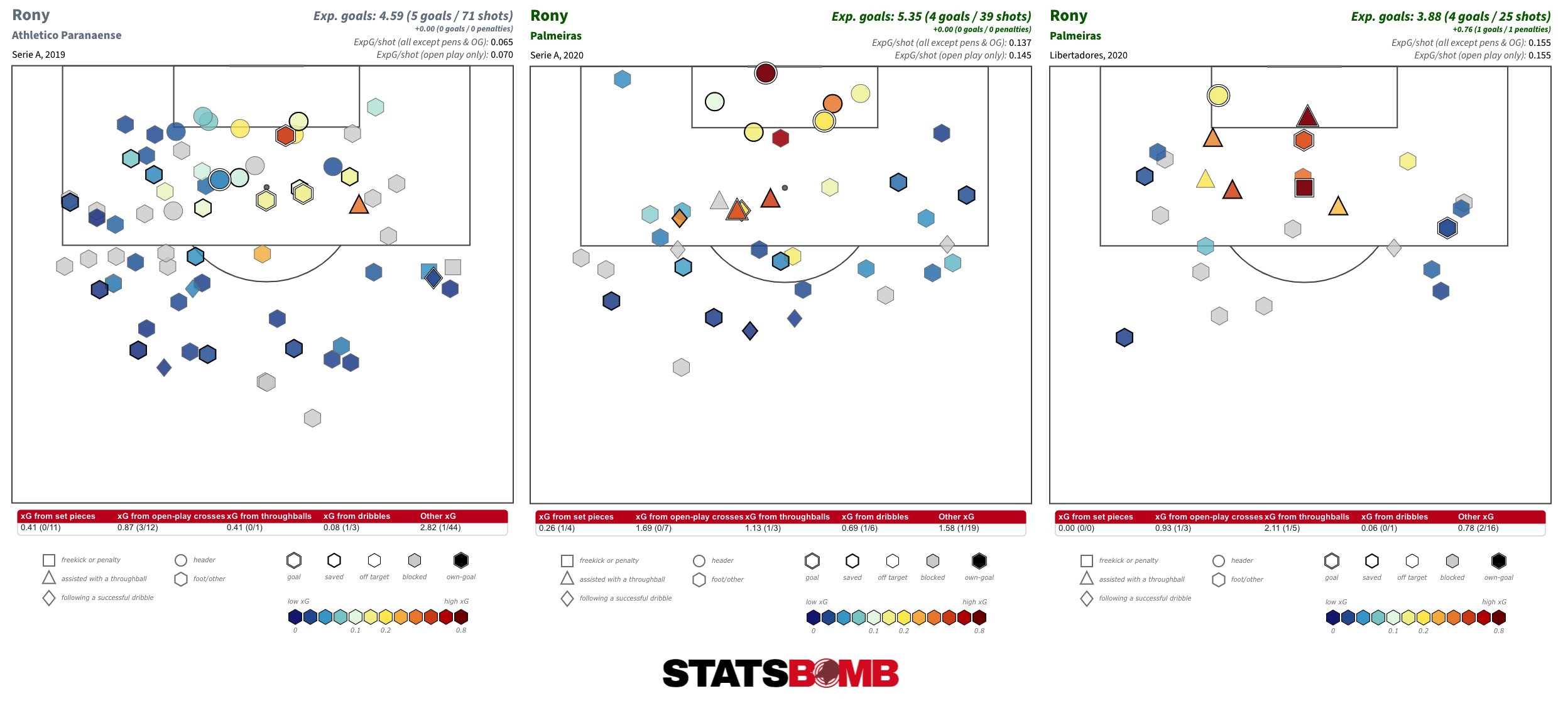 Rony is capable of playing on either side of the attack as well as through the centre, as he has done on occasion this season. With or without the ball, he aggressively attacks the penalty area. Only two wingers in the Brazilian top flight, Serie A, touch the ball there more often. Ferreira has a potent attack, with the former Shakhtar Donetsk striker Luiz Adriano at its centre and Willian, Raphael Veiga and the young Gabriel Veron as additional options in the wide positions. Some of them may have had better league seasons, but there can be no doubting that Rony has been the star of the Palmeiras attack in the Libertadores.
Rony is capable of playing on either side of the attack as well as through the centre, as he has done on occasion this season. With or without the ball, he aggressively attacks the penalty area. Only two wingers in the Brazilian top flight, Serie A, touch the ball there more often. Ferreira has a potent attack, with the former Shakhtar Donetsk striker Luiz Adriano at its centre and Willian, Raphael Veiga and the young Gabriel Veron as additional options in the wide positions. Some of them may have had better league seasons, but there can be no doubting that Rony has been the star of the Palmeiras attack in the Libertadores.
Yefferson Soteldo, Santos
Yefferson Soteldo is the key player in the Santos attack. He is at the centre of their ball progression in the attacking half... 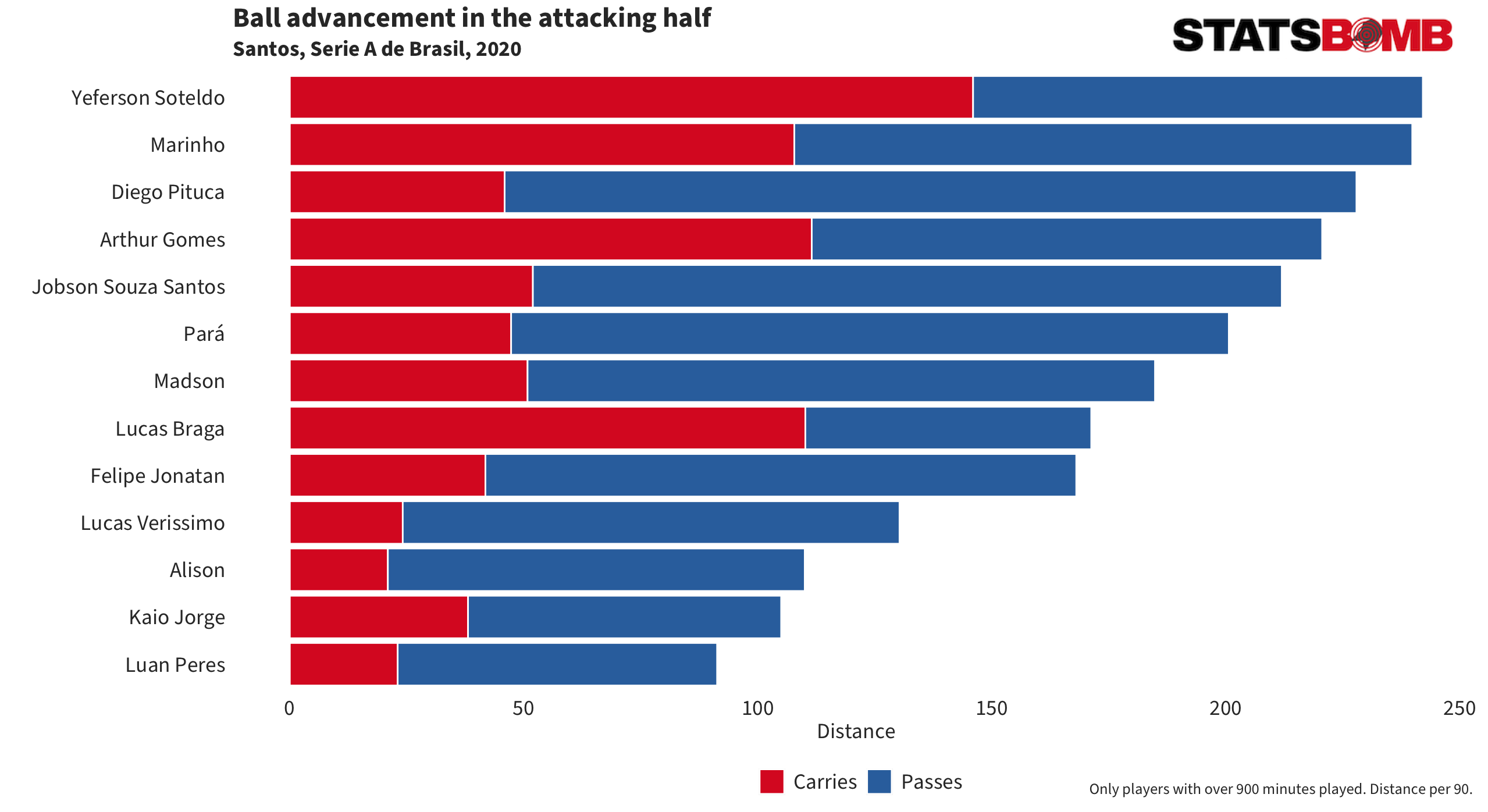 ...he creates more chances than anyone else...
...he creates more chances than anyone else... 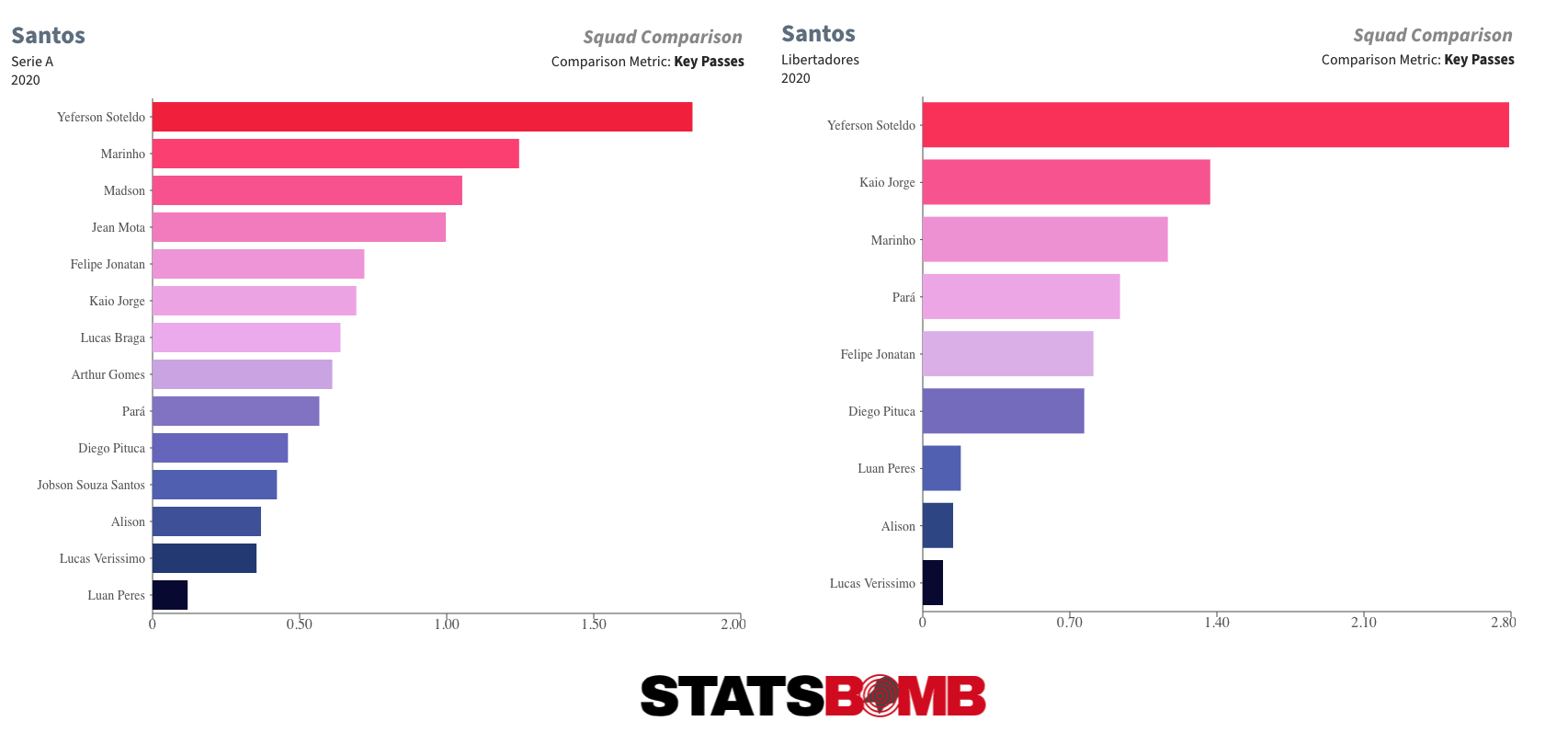 ...and he even gets himself on the scoresheet sometimes, too, as he did in the return leg of the semi-final against Boca Juniors.
...and he even gets himself on the scoresheet sometimes, too, as he did in the return leg of the semi-final against Boca Juniors. 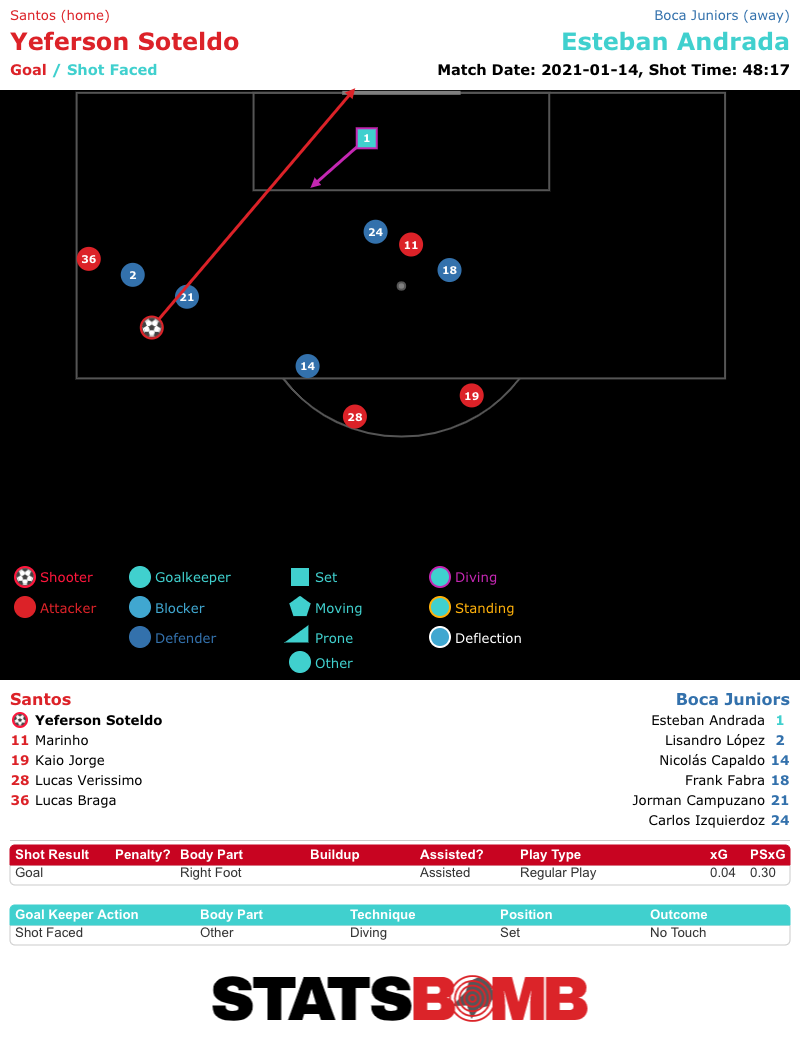 The pint-sized Venezuelan doesn’t stand out for his ability to break defensive lines with his passing. Amongst all the attacking midfielders and wingers of Serie A, he ranks among those who least often pass the ball forward, both in general and in the final third. But when there is space to attack or when he creates space off the dribble, he is the accelerator of his team’s attacks, driving forward purposefully with the ball at his feet.
The pint-sized Venezuelan doesn’t stand out for his ability to break defensive lines with his passing. Amongst all the attacking midfielders and wingers of Serie A, he ranks among those who least often pass the ball forward, both in general and in the final third. But when there is space to attack or when he creates space off the dribble, he is the accelerator of his team’s attacks, driving forward purposefully with the ball at his feet. 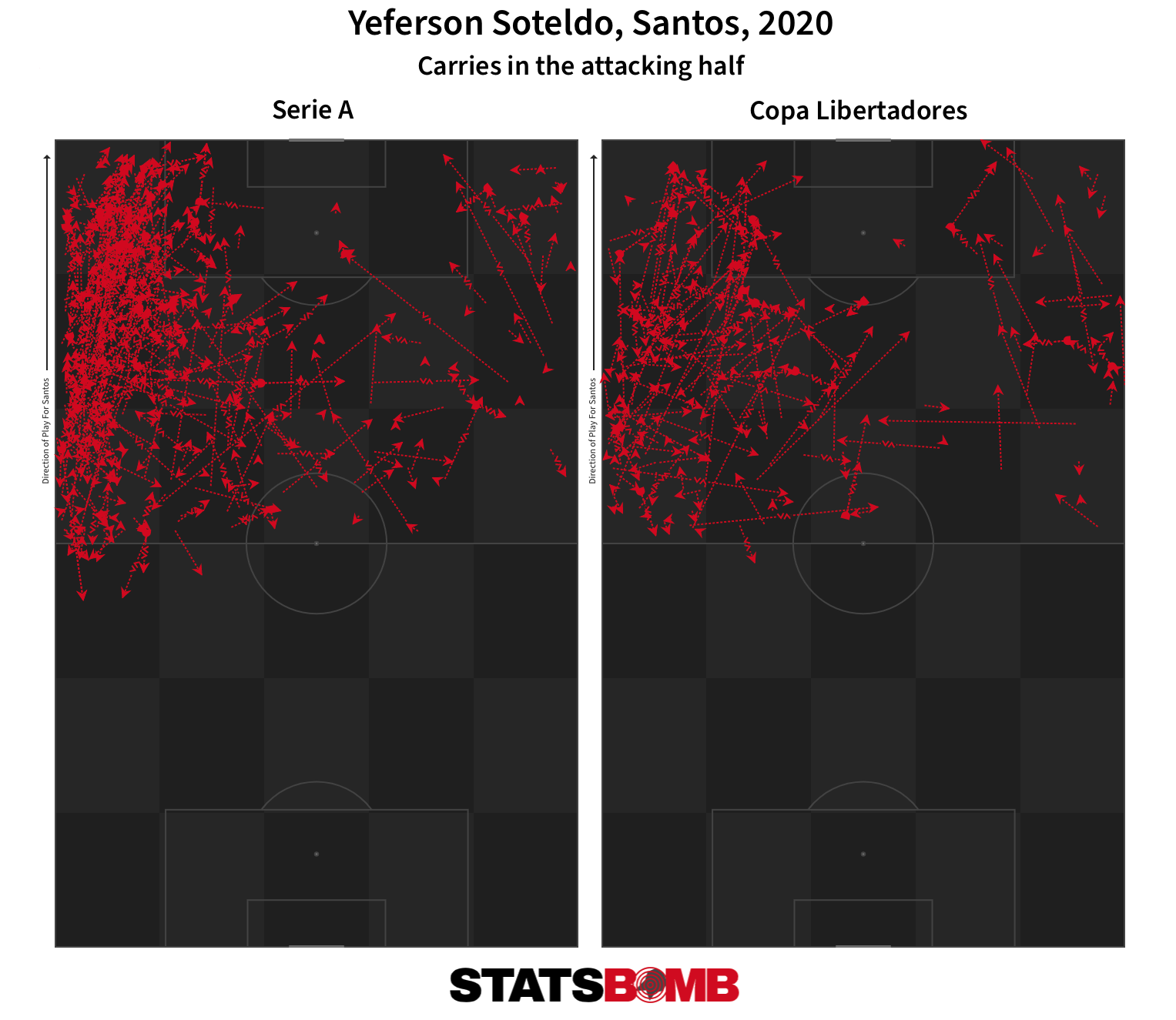 At an individual level, Soteldo is Santos’ most important player. If he plays well on Saturday, their chances of lifting the Libertadores trophy will be greatly increased.
At an individual level, Soteldo is Santos’ most important player. If he plays well on Saturday, their chances of lifting the Libertadores trophy will be greatly increased.
Gabriel Menino, Palmeiras
Among the primary draws of the Libertadores is that it is a competition studded with ascendant stars, and few enjoyed as ascendant a 2020 as Gabriel Menino. He made his first team debut in January, quickly established himself as a regular starter and was then called up to the Brazil national team in September. Now, after a standout performance in the first leg of the Libertadores semi-final against River Plate, he has the chance to continue his upward momentum in 2021. Menino played as a midfielder in the Palmeiras youth teams, and although he has shown himself to be a versatile player in the first team, playing at full-back, in central midfield and even as an attacking midfielder, he interprets every position in pretty much the same way. National team coach Tite considers him an interesting option at right-back precisely because of his natural inclination to step infield and join the midfield line. The 20-year-old is not especially quick but he does have the necessary strength and technical ability to retain possession under pressure and free himself of his marker to advance the ball via passes or carries. In Serie A, where we have a bigger sample size, he has an important role in progressing the ball forward inside the attacking half, something that is also reflected in a smaller sample in the Libertadores. 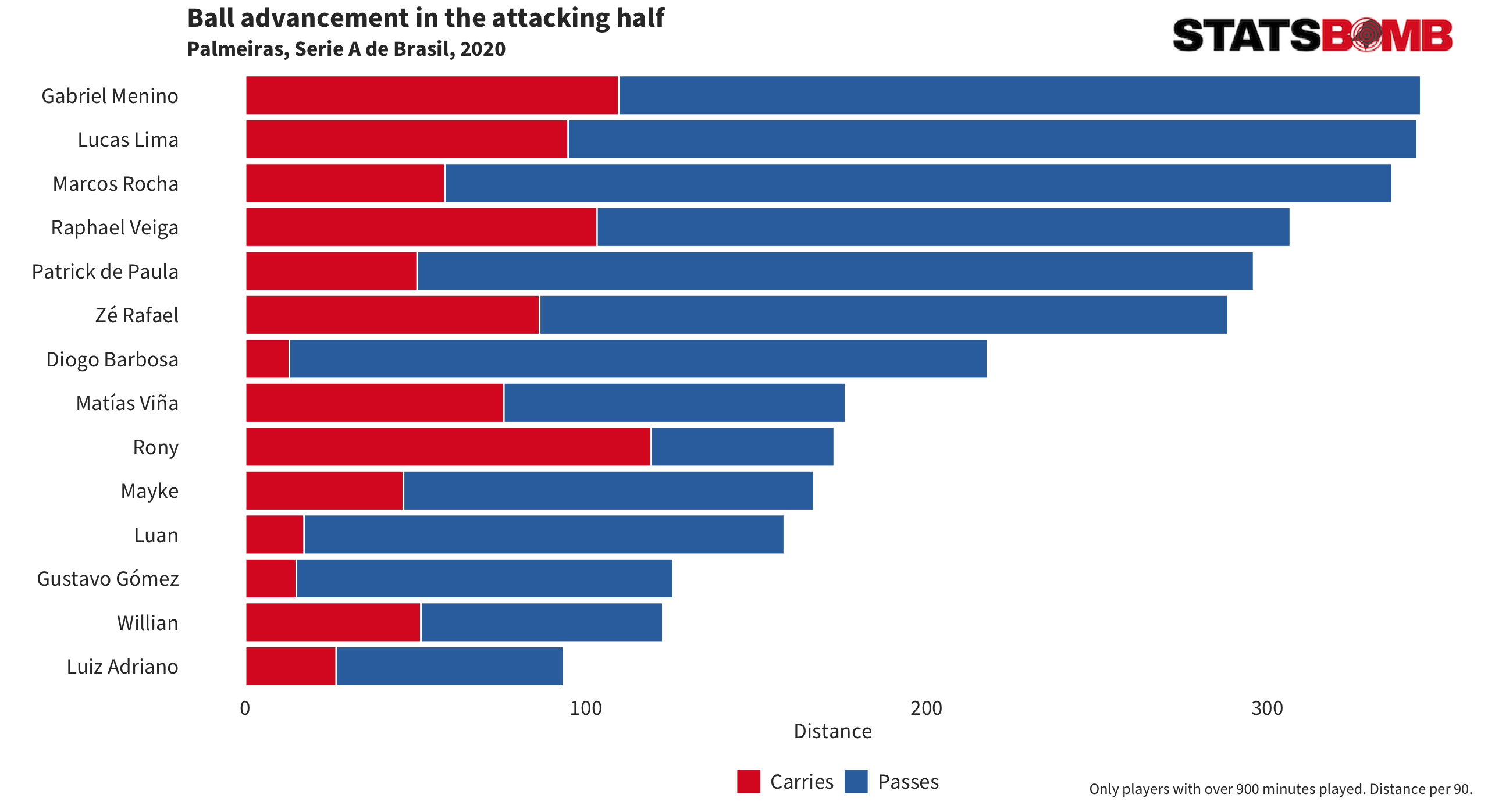 Menino also provides some output in the final third, with between 2.5 and 2.8 shots and key passes per 90 between the Libertadores and Serie A -- solid figures given the amount of minutes he has played at full-back in both competitions.
Menino also provides some output in the final third, with between 2.5 and 2.8 shots and key passes per 90 between the Libertadores and Serie A -- solid figures given the amount of minutes he has played at full-back in both competitions.
Marinho, Santos
Marinho is a wide forward by trade, but he is Santos’ primary shot-taker. 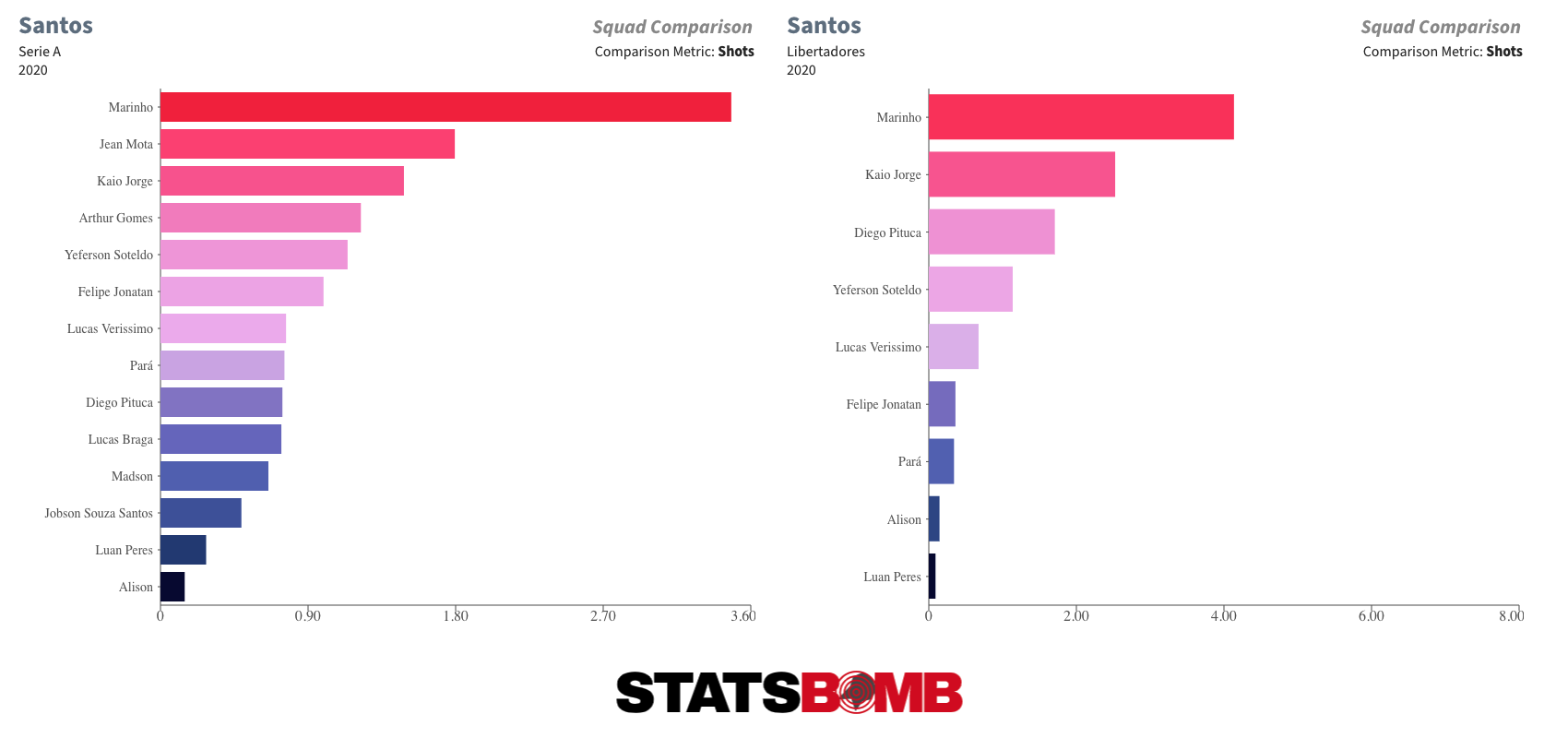 Eighteen-year old Kaio Jorge has a more collaborative and supporting role in the centre of the Santos attack -- although he has been more active inside the penalty area during the Libertadores run than he has in the Brazilian league -- and Marinho is the player who takes most advantage of the space created by his movement, cutting in diagonally from the right flank to get off shots.
Eighteen-year old Kaio Jorge has a more collaborative and supporting role in the centre of the Santos attack -- although he has been more active inside the penalty area during the Libertadores run than he has in the Brazilian league -- and Marinho is the player who takes most advantage of the space created by his movement, cutting in diagonally from the right flank to get off shots. 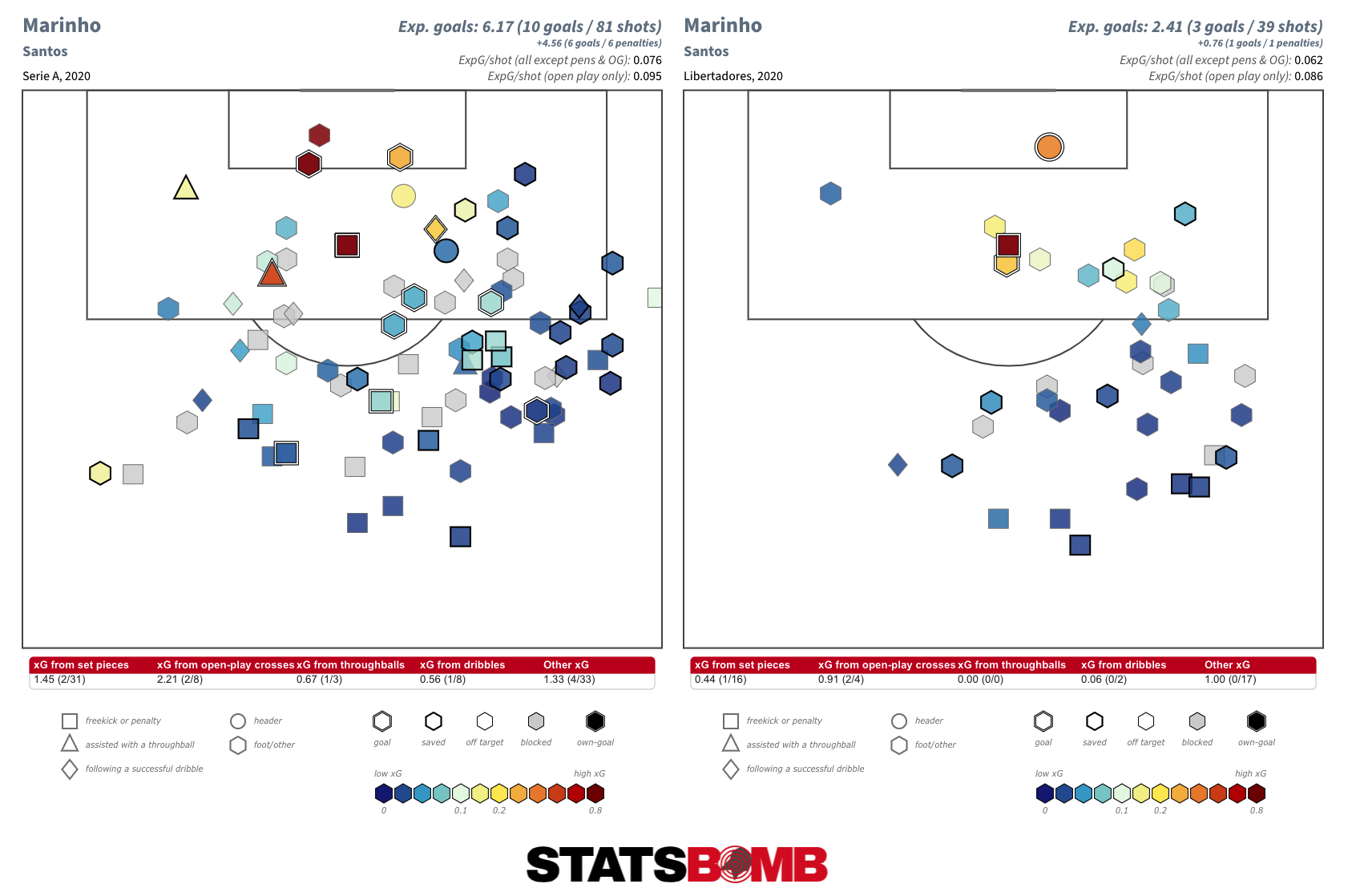 His shot locations do leave something to be desired. If he were still a young player with an opportunity to move on to Europe, it would be something to be worked on and refined. As it is, with a total of 13 non-penalty goals across the Libertadores and the league, the 30-year-old is in the best form of his career. At this stage, he likely is what he is, and this season it is definitely working out for him. Marinho is not an especially efficient player, but he is very active inside the final third and could have a decisive role to play in Saturday’s final.
His shot locations do leave something to be desired. If he were still a young player with an opportunity to move on to Europe, it would be something to be worked on and refined. As it is, with a total of 13 non-penalty goals across the Libertadores and the league, the 30-year-old is in the best form of his career. At this stage, he likely is what he is, and this season it is definitely working out for him. Marinho is not an especially efficient player, but he is very active inside the final third and could have a decisive role to play in Saturday’s final.
The Big 5 After 5: Serie A
We complete our roundup of the first five matchdays of action in the major European leagues with a look at some early trends in Serie A. The Highest Scoring of the Big Five Leagues Anyone still clinging to that age-old stereotype of Italian football being boring and defensive needs to readjust to the current reality: Serie A is the highest scoring major league in Europe. Just a glance at last weekend’s results provides a flavour of what the league is now producing. There were two 3-3s, a 4-2, a 3-2 and a 2-2. Not a single encounter ended scoreless. In fact, there has only been one 0-0 draw in the 48 matches (actually) played so far this season. Serie A saw a stable 2.68 goals, between 2.43-2.44 non-penalty goals and 2.36-2.39 expected goals (xG) per match through the 2017-18 and 2018-19 seasons, but those figures shot up to 3.04 goals, 2.64 non-penalty goals and 2.54 xG last time around. That has increased again in the early running of the new campaign, with an average of 3.75 goals per match. That isn’t inflated by an abnormally high penalty count either, as around one penalty goal for every three matches is consistent with the recent average across the major leagues. The average of 3.44 non-penalty goals per match is also comfortably the highest mark across the big five. The early pace is eventually likely to ease off a little. That average of 3.44 non-penalty goals per match is around 116% of the xG sum of 2.96, which is marginally higher than the highest overperformance in any 48-match sample last season, although nowhere near as extreme as the 130% rate across the first five matchdays of the Premier League season. The xG sum itself is also comfortably ahead of any 48-match sample last season. But unless something dramatic occurs, Serie A will remain the prime choice for goal hungry viewers. Just maybe don’t tune in to Hellas Verona. Their matches were some of the lowest scoring in the league last season, and that has carried over into the new campaign, with their encounters featuring the lowest number of both goals (1.40) and xG (2.41). Finally a New Champion? Juventus are seeking a 10th consecutive Serie A title this season, but it is probably fair to say that their long run of successes is in more danger of coming to an end this time around than in any previous campaign. That is partly because of their own level. Last season’s total of 83 points was their lowest in any season in their title-winning streak, and they only had the fourth-best metrics in the division. It is actually necessary to go back to 2016-17 to find the last time Juve had the best underlying numbers in Serie A, despite the fact they’ve continued to accumulate titles. The gift of three points from their unplayed match against Napoli has helped them take nine from their opening five matches of the new campaign, but they’ve not looked convincing in Andrea Pirlo’s first steps as a head coach. Inter and Napoli both had marginally better underlying numbers last season and have both picked up more points with better metrics in the early running of 2020-21. Antonio Conte and Inter finished just a point behind Juventus last season and look particularly well-placed to challenge strongly. In fact, most bookmakers now have them as the favourites for the title. But there is also another potential challenger in the form of early leaders AC Milan, who have carried their excellent form from the back end of last season into the new campaign. No team picked up as many points as the Rossoneri between the resumption of action in June and the end of the season, and only Inter had better metrics. 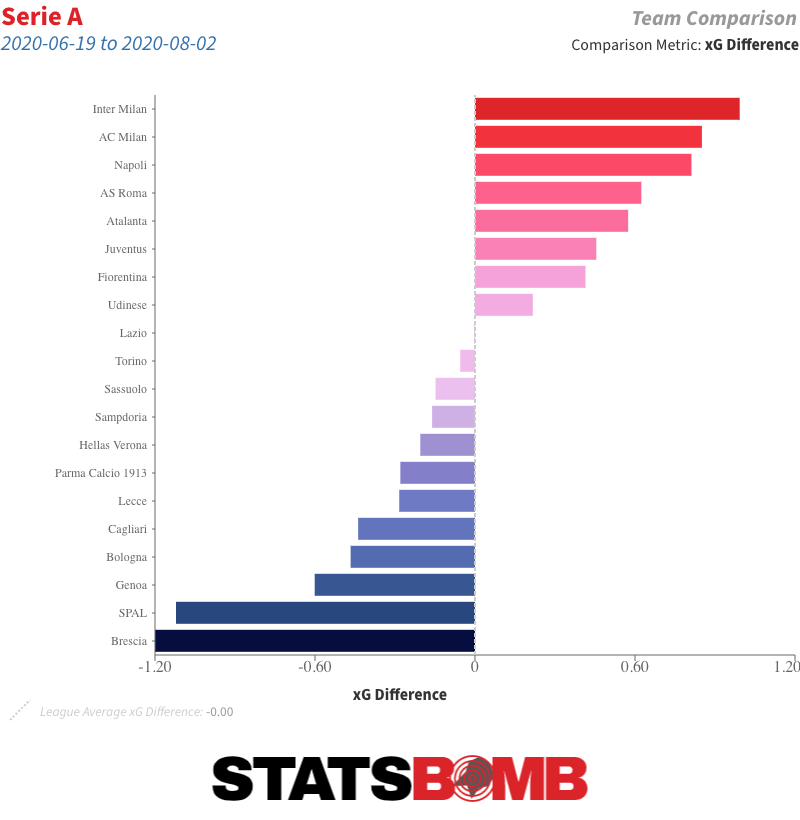 Milan’s recent focus on the signing of the young players seems to be bearing fruit, although it is notable that Zlatan Ibrahimović has been their primary goalscorer since his return in January. We’re not sure if it says more about Ibrahimović or the openness of the league that he’s still putting up numbers like this at the tail end of his 30s.
Milan’s recent focus on the signing of the young players seems to be bearing fruit, although it is notable that Zlatan Ibrahimović has been their primary goalscorer since his return in January. We’re not sure if it says more about Ibrahimović or the openness of the league that he’s still putting up numbers like this at the tail end of his 30s.  We haven’t even mentioned Atalanta yet, arguably the most entertaining team in Europe, and certainly the one with the best metrics in Serie A last season. They’ve made a slightly less impressive start to the new campaign, although their matches remain the most open in the league, with 4-2, 4-1 and 5-2 victories followed by 4-1 and 3-1 defeats.
We haven’t even mentioned Atalanta yet, arguably the most entertaining team in Europe, and certainly the one with the best metrics in Serie A last season. They’ve made a slightly less impressive start to the new campaign, although their matches remain the most open in the league, with 4-2, 4-1 and 5-2 victories followed by 4-1 and 3-1 defeats.
The Big 5 After 5: Bundesliga
We are five matchdays into the new Bundesliga season, so let’s have a look at a couple of interesting things from the early action. Predictable Leaders The Bundesliga has taken a lot less time to shake out than many of the other major European leagues, with the top three spots in the table currently filled by the top three teams from last season: Bayern Munich, Borussia Dortmund and RB Leipzig. Not only that, but the three of them also have the best underlying numbers in the division. Aside from a surprise 4-1 defeat away to Hoffenheim, champions Bayern are humming along just fine, scoring four or more goals in each of their four victories. Dortmund also have a loss on the board, but have won all of their remaining matches to nil. RB Leipzig lead the way early on with four wins and a draw from a kinder opening schedule. Even at this extremely early stage of the campaign, it would take a brave person to back another team to finish in the top three, and perhaps an even braver one to back anyone but Bayern for the title. Hans Flick’s side finished 13 points clear of second last season after winning nine on the bounce following the return to play to May, and then successfully made their way through the final four rounds of the Champions League to become champions of Europe. Aside from that Hoffenheim anomaly (4-1 on the scoreboard; 3.98-1.64 by expected goals), they’ve been dominant so far, outshooting their remaining opponents 79-33, and accumulating 13.44 xG while conceding just 3.48. We are only five matches in and the usual caveats about small sample sizes obviously still apply, but it is difficult to see Bayern relinquishing their mightily firm grip on the Bundesliga title. Robert Lewandowski has also made a great start in his attempt to finish the season as the league’s top scorer for a fourth consecutive campaign. 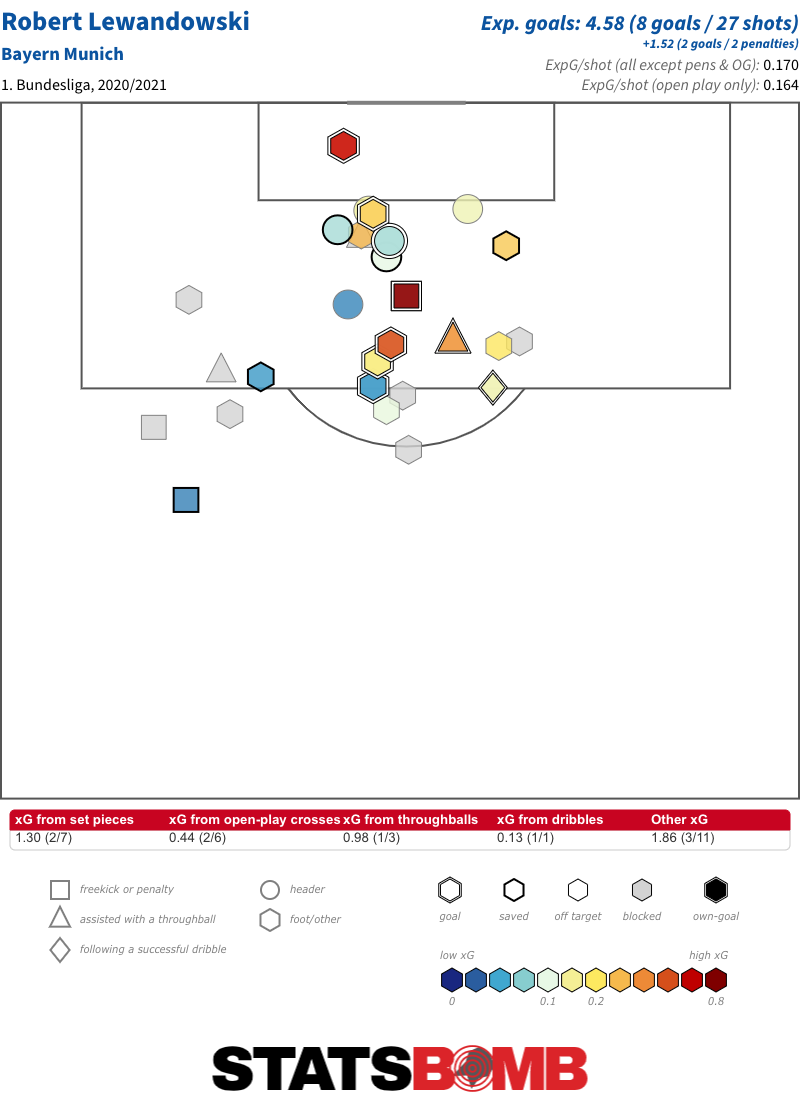 How bad are Schalke? Schalke are second from bottom after picking up just a single point from their opening five fixtures. More globally, they are now winless in their last 21 Bundesliga matches -- the joint second worst run in the history of the league. Their one and only league win this calendar year came way back on 17th January in a 2-0 triumph at home to Borussia Mönchengladbach. Are they really that bad? In a certain sense, the answer is yes. With penalties included, they’ve given up an average of over two goals per match to their opponents during this run. Extrapolated to a full campaign that would have resulted in comfortably the worst goal difference in the Bundesliga last season. With penalties removed, the average drops to 1.86, which is some way ahead of their average xG deficit of 0.98 per match, but that latter figure would still again have comfortably been the worst in the league last season. So we can pretty confidently state that as currently constituted, Schalke are a bad team. Even so, the likelihood of them putting together a run of 21 matches without victory is still very low. The race charts in StatsBomb IQ display the probability of a match ending in a home win, an away win or a draw based on the balance of chances. We can use these probabilities from each of the 21 matches in their winless streak to establish the cumulative probability of them failing to secure a single victory in that time. It’s worth noting that they are some dreadful performances in here, including four matches in which Schalke’s opponents had a 90% or better chance of winning given the balance of chances. Only once did Schalke’s win probability stand at over 50%. There was an 80% or better chance of them failing to win in 14 of the 21 matches. But if you stack them all, even a team playing as badly as they have done during this run would usually have sneaked a victory or two along the way. The probability of them failing to win all 21 of the matches stands at just under 1.5%. So while performances this calendar year and since the start of this season certainly have Schalke pegged as likely relegation candidates, it wouldn’t be at all surprising if they were to bring their winless run to an end before they reach the Bundesliga record of 31 matches without victory, set by Tasmania Berlin way back in the mid-sixties.
How bad are Schalke? Schalke are second from bottom after picking up just a single point from their opening five fixtures. More globally, they are now winless in their last 21 Bundesliga matches -- the joint second worst run in the history of the league. Their one and only league win this calendar year came way back on 17th January in a 2-0 triumph at home to Borussia Mönchengladbach. Are they really that bad? In a certain sense, the answer is yes. With penalties included, they’ve given up an average of over two goals per match to their opponents during this run. Extrapolated to a full campaign that would have resulted in comfortably the worst goal difference in the Bundesliga last season. With penalties removed, the average drops to 1.86, which is some way ahead of their average xG deficit of 0.98 per match, but that latter figure would still again have comfortably been the worst in the league last season. So we can pretty confidently state that as currently constituted, Schalke are a bad team. Even so, the likelihood of them putting together a run of 21 matches without victory is still very low. The race charts in StatsBomb IQ display the probability of a match ending in a home win, an away win or a draw based on the balance of chances. We can use these probabilities from each of the 21 matches in their winless streak to establish the cumulative probability of them failing to secure a single victory in that time. It’s worth noting that they are some dreadful performances in here, including four matches in which Schalke’s opponents had a 90% or better chance of winning given the balance of chances. Only once did Schalke’s win probability stand at over 50%. There was an 80% or better chance of them failing to win in 14 of the 21 matches. But if you stack them all, even a team playing as badly as they have done during this run would usually have sneaked a victory or two along the way. The probability of them failing to win all 21 of the matches stands at just under 1.5%. So while performances this calendar year and since the start of this season certainly have Schalke pegged as likely relegation candidates, it wouldn’t be at all surprising if they were to bring their winless run to an end before they reach the Bundesliga record of 31 matches without victory, set by Tasmania Berlin way back in the mid-sixties.
Argentina Copa de la Liga Profesional 2020 Season Preview
Football returns to Argentina this week following a seven-month absence due to the COVID-19 pandemic. Vicente Muglia, Olé journalist and author of the book Che Pep, joins us to preview the Copa de la Liga Profesional 2020, which opens with Gimnasia La Plata against Patronato on Friday. Nick Dorrington, Content Manager at StatsBomb (ND): Hi Vicente. Thanks for giving up your time to speak to us. We are going to kick off with the top two from last season (the Superliga 2019-20), River Plate and the champions Boca Juniors, two teams with differing approaches. Could you summarise the key points of their respective play styles? Vicente Muglia (VM): Throughout Marcelo Gallardo’s tenure, River have stood out as a team who take the initiative in two ways: through possession and with a high press. When they have the ball, they are a dangerous team because they are quite direct, they don’t chain together a lot of passes but instead seek to move forward, take advantage of space or create it, all by means of an unwavering tactical intensity. Without the ball, they have a well-oiled pressing system which is consistently effective in winning it back. The forwards are the team’s first defenders. When they win the ball back in opposition territory, they attack decisively to take full advantage of the transitional phase. ND: It is something that is clearly visible in the data. Last season, River utilised an aggressive high press, with only Argentinos Juniors contesting the ball more intensely in opposition territory. 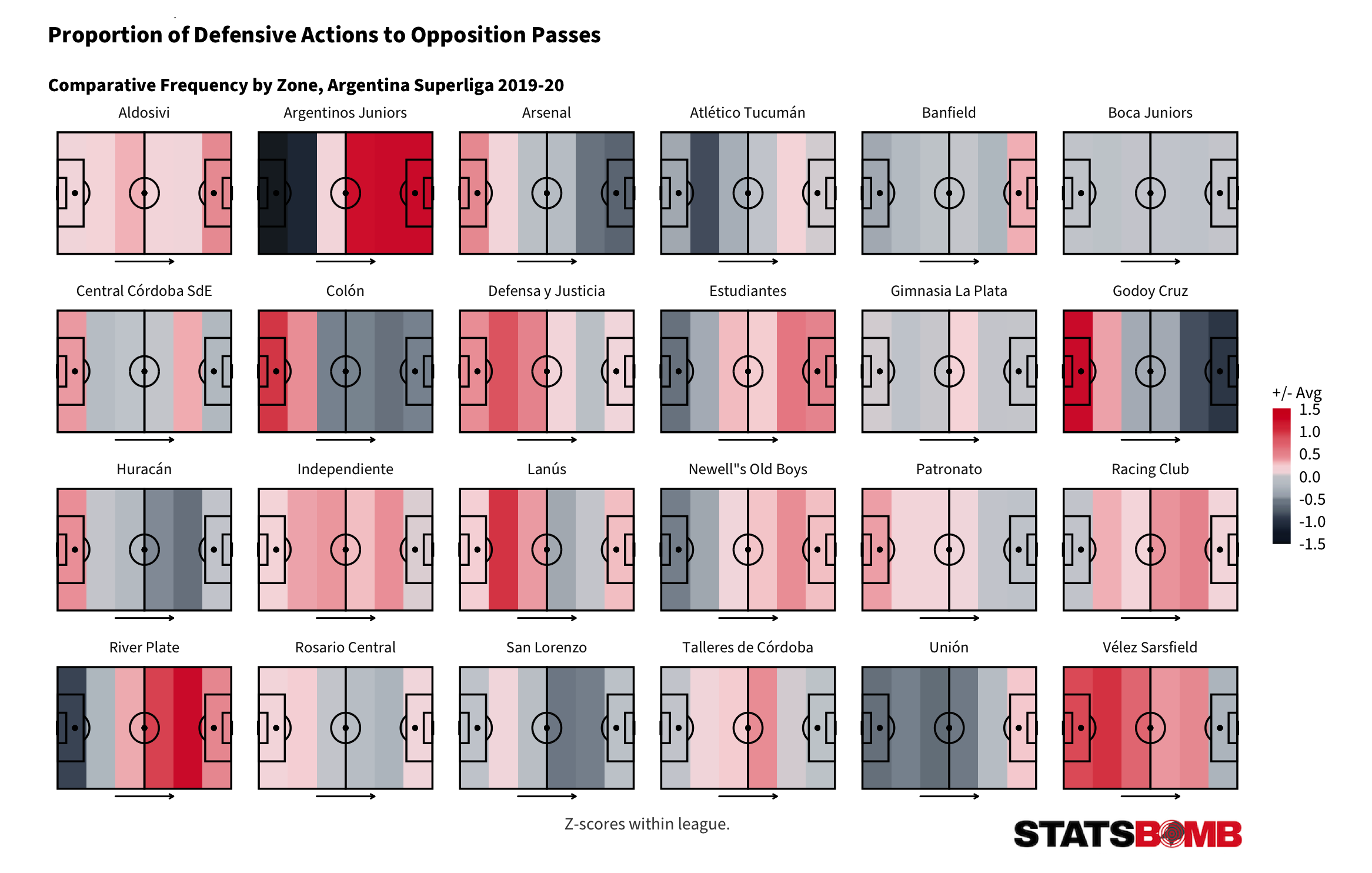 River were also the team who generated the most shots after winning the ball back high up the pitch.
River were also the team who generated the most shots after winning the ball back high up the pitch. 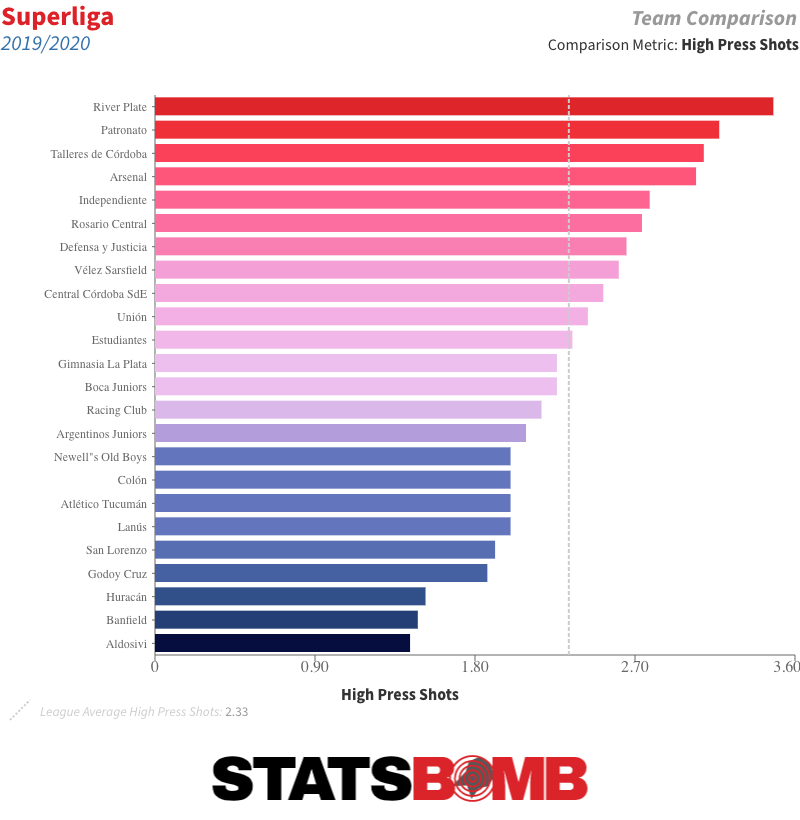 Both visualisations make it clear that Boca, coached by the experienced Miguel Ángel Russo, have a very different play style. VM: Yes. In contrast to River, Boca don’t usually press high but instead focus on winning the ball back in the centre of the pitch and then attacking quickly from there. They are a direct team, who don’t elaborate as much as River. The key to last season’s championship was the damage they did down the flanks. Julio Buffarini and Eduardo Salvio on the right and Frank Fabra and Sebastián Villa on the left spread the pitch, got in behind and destabilised opposing defences. Boca also had the very steady Jorman Campuzano in midfield, and Carlos Tévez up front, who was intelligent in finding space and rationing his efforts. ND: In addition to being the team’s top scorer, Tévez played a very important role in ball progression. He dropped back to receive and combine with teammates, and on a per-90 basis, only Emanuel Reynoso, now of Minnesota United in MLS, moved the ball into the final third more often and played more open play passes into the penalty area than Tévez.
Both visualisations make it clear that Boca, coached by the experienced Miguel Ángel Russo, have a very different play style. VM: Yes. In contrast to River, Boca don’t usually press high but instead focus on winning the ball back in the centre of the pitch and then attacking quickly from there. They are a direct team, who don’t elaborate as much as River. The key to last season’s championship was the damage they did down the flanks. Julio Buffarini and Eduardo Salvio on the right and Frank Fabra and Sebastián Villa on the left spread the pitch, got in behind and destabilised opposing defences. Boca also had the very steady Jorman Campuzano in midfield, and Carlos Tévez up front, who was intelligent in finding space and rationing his efforts. ND: In addition to being the team’s top scorer, Tévez played a very important role in ball progression. He dropped back to receive and combine with teammates, and on a per-90 basis, only Emanuel Reynoso, now of Minnesota United in MLS, moved the ball into the final third more often and played more open play passes into the penalty area than Tévez. 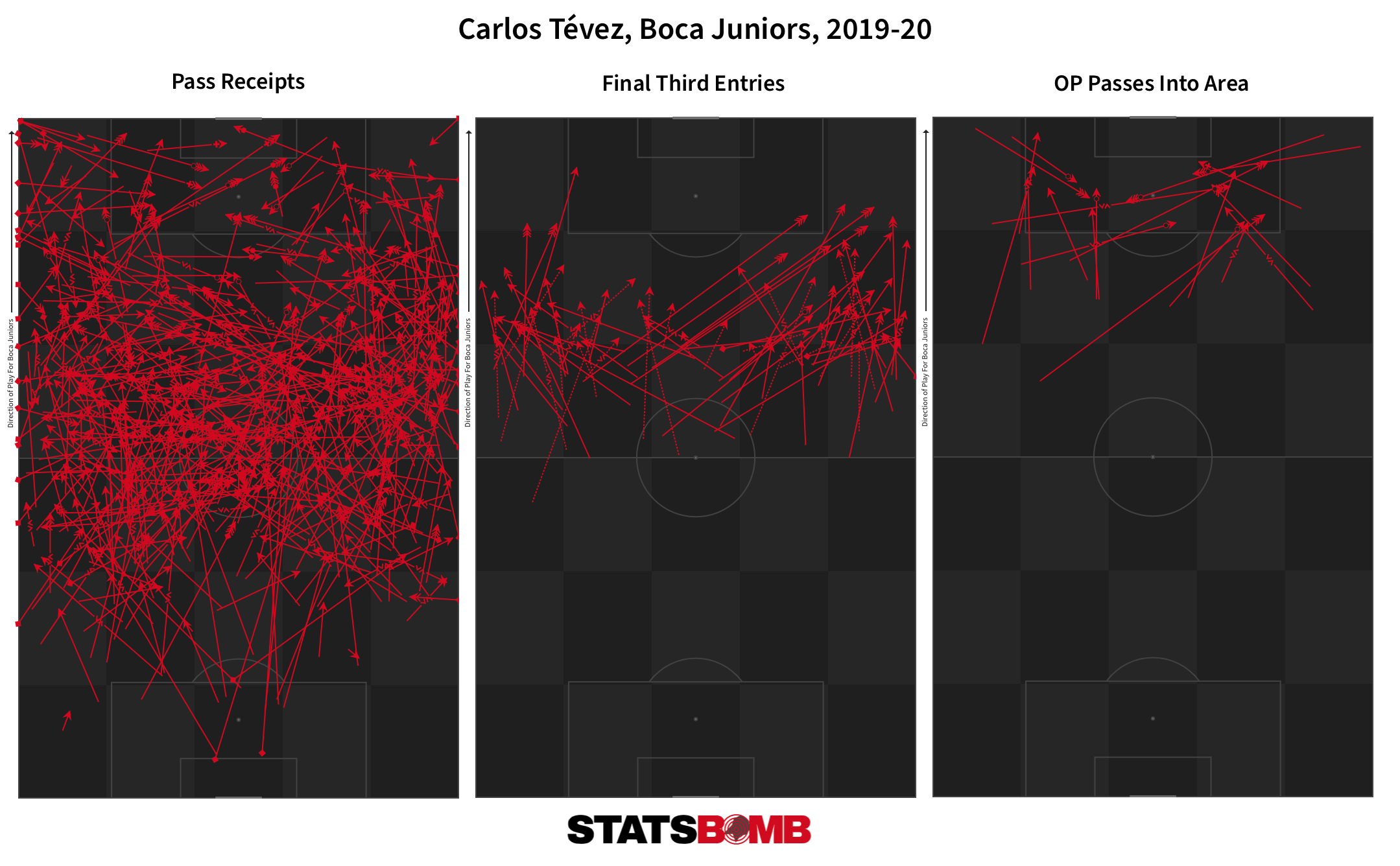 How are Boca and River looking ahead of this tournament? The format is a bit convoluted and so luck is likely to play a larger role than it would in a traditional league format, but are they still the two favourites to win it? VM: Even though River have lost Lucas Martínez Quarta and Juan Fernando Quintero, and Boca are unable to count on Villa due to off-pitch issues, they are still the two strongest teams in Argentinian football both in terms of collective performances and individual quality. They have the two best squads. Without a doubt, they remain the main candidates to lift the trophy. Prior to the start of the tournament, I don’t see another team equipped to compete with them for the trophy in normal conditions. ND: It’s worth mentioning that River had the best expected goal (xG) difference last season, and by some distance.
How are Boca and River looking ahead of this tournament? The format is a bit convoluted and so luck is likely to play a larger role than it would in a traditional league format, but are they still the two favourites to win it? VM: Even though River have lost Lucas Martínez Quarta and Juan Fernando Quintero, and Boca are unable to count on Villa due to off-pitch issues, they are still the two strongest teams in Argentinian football both in terms of collective performances and individual quality. They have the two best squads. Without a doubt, they remain the main candidates to lift the trophy. Prior to the start of the tournament, I don’t see another team equipped to compete with them for the trophy in normal conditions. ND: It’s worth mentioning that River had the best expected goal (xG) difference last season, and by some distance. 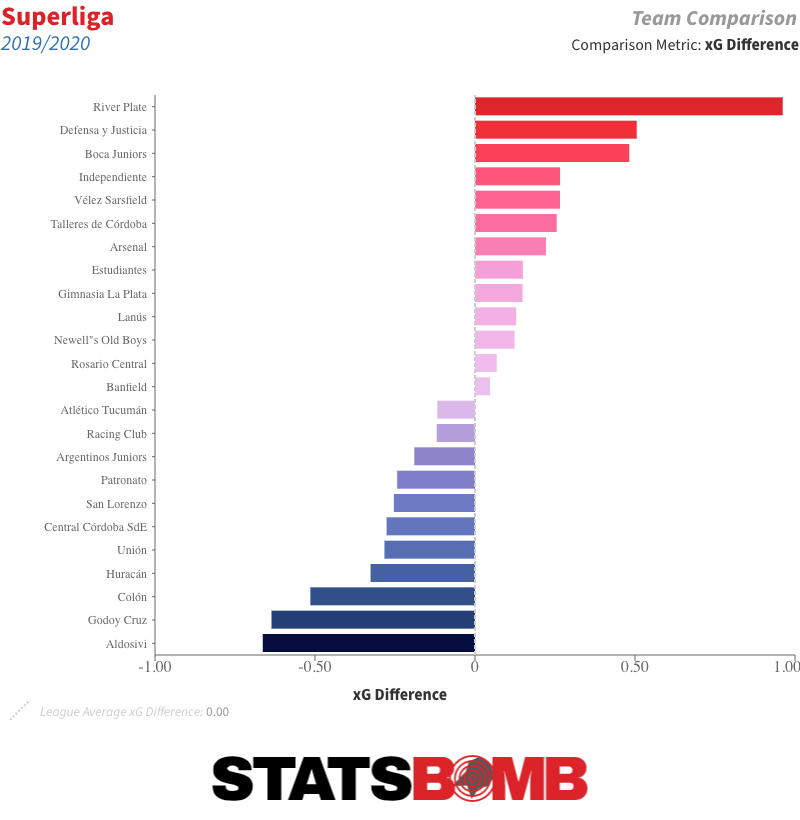 Boca performed well above expectation in defence, letting in just eight goals. Our data suggests the excellent performances of their goalkeeper Esteban Andrada were a contributory factor, but it doesn’t explain all of the difference. It is unlikely they will again concede so few goals.
Boca performed well above expectation in defence, letting in just eight goals. Our data suggests the excellent performances of their goalkeeper Esteban Andrada were a contributory factor, but it doesn’t explain all of the difference. It is unlikely they will again concede so few goals. 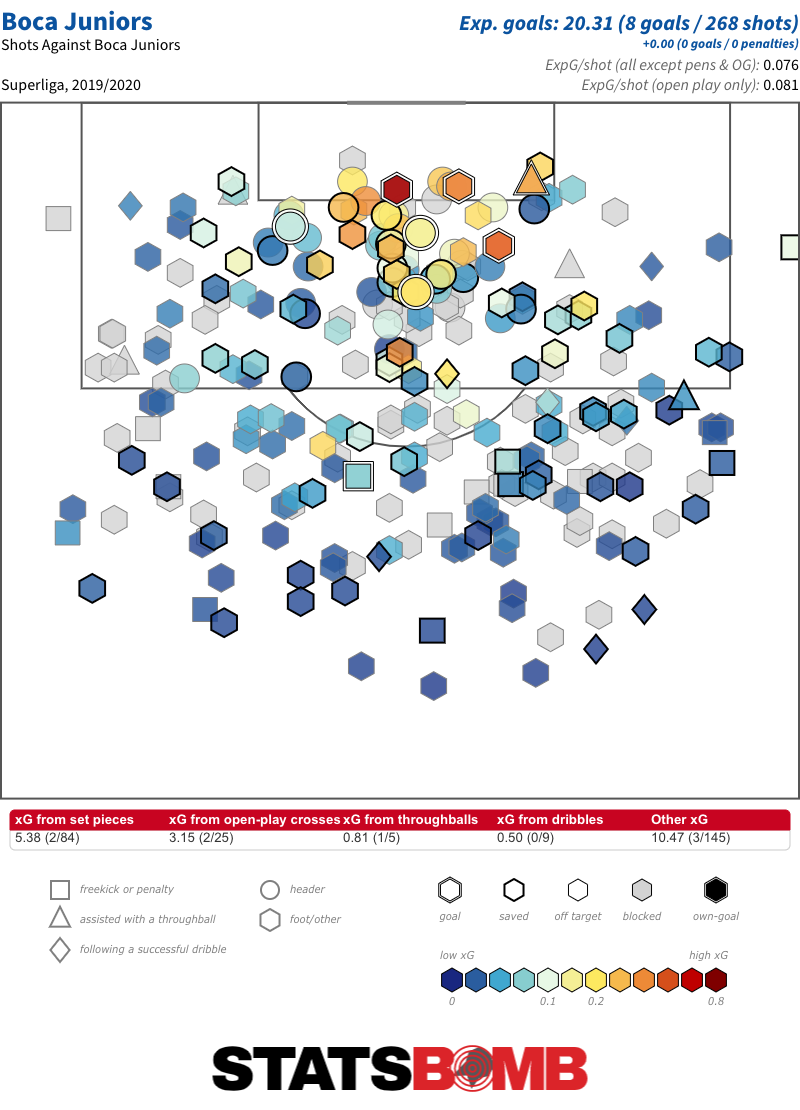 Are there some other teams with interesting play styles? VM: Racing and Defensa y Justicia have a pair of young coaches in Sebastián Beccacece and Hernán Crespo who, despite having different play styles, both seek to take the initiative and attack. They are teams who construct play from the back, move forward and are aggressive in attack. They don’t speculate. Although the feeling is that both of them need to find a bit more consistency, not only in terms of results but also in terms of their play. NM: The underlying numbers suggest that Crespo has better base to work from than Beccacece, but we will see how things play out. Another team who intrigue me are Argentinos Juniors. As we’ve already noted, they utilised a very aggressive high press last season, but they didn’t combine it with a high share of possession. They were a much more direct team than River or Vélez Sarsfield, for example. They finished fifth, but they scored less than a goal per match and struggled to create good quality chances.
Are there some other teams with interesting play styles? VM: Racing and Defensa y Justicia have a pair of young coaches in Sebastián Beccacece and Hernán Crespo who, despite having different play styles, both seek to take the initiative and attack. They are teams who construct play from the back, move forward and are aggressive in attack. They don’t speculate. Although the feeling is that both of them need to find a bit more consistency, not only in terms of results but also in terms of their play. NM: The underlying numbers suggest that Crespo has better base to work from than Beccacece, but we will see how things play out. Another team who intrigue me are Argentinos Juniors. As we’ve already noted, they utilised a very aggressive high press last season, but they didn’t combine it with a high share of possession. They were a much more direct team than River or Vélez Sarsfield, for example. They finished fifth, but they scored less than a goal per match and struggled to create good quality chances. 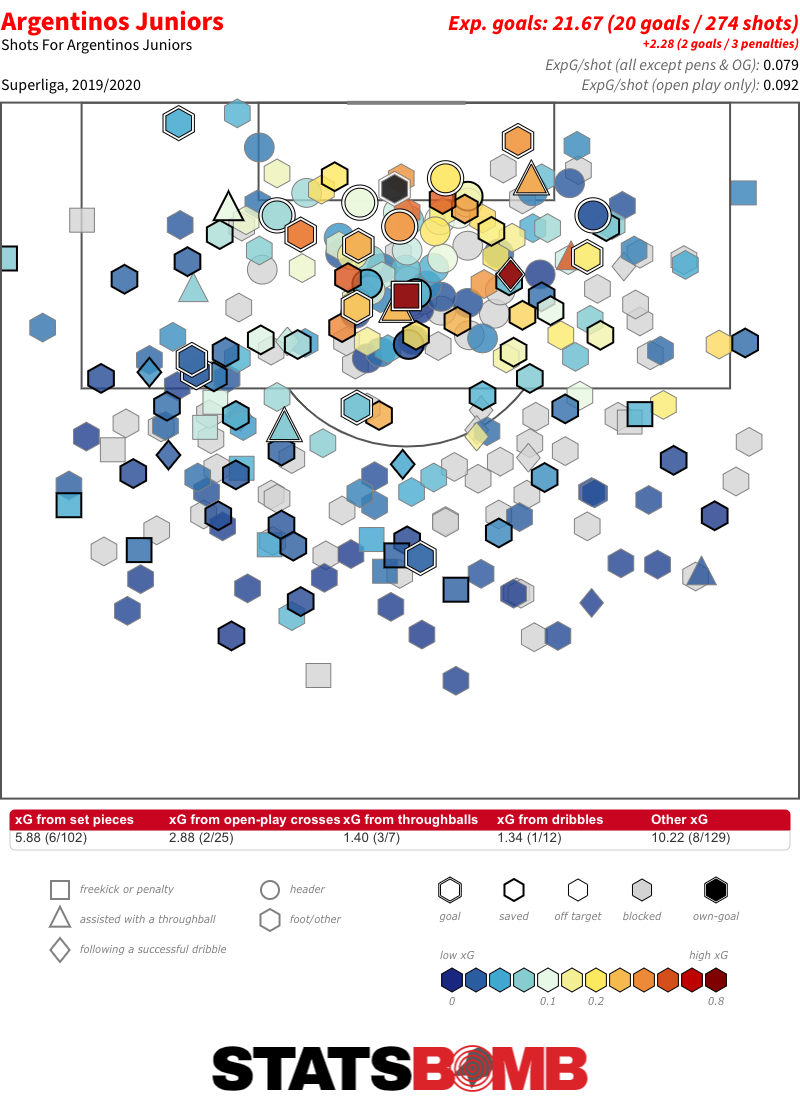 It will be interesting to see if Diego Dabove is capable of developing that aspect of their game. Have there been any interesting coaching changes? VM: Mauricio Pellegrino has replaced Gabriel Heinze at Vélez. It will be a big challenge for the club to maintain the level of competitiveness they had under Heinze, who elevated both the individual and collective level with an approach based around positional play. Pellegrino, returning to the country after a number of years in Europe, is more focused on maintaining balance. He takes less risks. We’ll have to see how the squad adapt to his style. ND: It’s a significant shift. If we take another look at the PPDA by Zone graphic above, we can see that Heinze’s Vélez pressed aggressively across pretty much the entire pitch. It looks very similar to what we see from Marcelo Bielsa’s teams. In contrast, Pellegrino was a much more reactive coach during his time in Spain, although admittedly with smaller teams. VM: There is also Mariano Soso, a young coach with some interesting ideas based around a distinctly attacking approach, who has taken charge at San Lorenzo. There, too, it remains to be seen whether he can convince his players to carry out his game model. ND: Which team made the best moves in the transfer market? VM: Due to the pandemic, there haven’t been many big moves in this window. I think Estudiantes de La Plata made the best signings. They’ve strengthened with Nicolás Pasquini from Lanús, Leonardo Godoy from Talleres de Córdoba and Leandro Díaz from Atlético Tucumán, three footballers who were starters at their respective clubs last season.
It will be interesting to see if Diego Dabove is capable of developing that aspect of their game. Have there been any interesting coaching changes? VM: Mauricio Pellegrino has replaced Gabriel Heinze at Vélez. It will be a big challenge for the club to maintain the level of competitiveness they had under Heinze, who elevated both the individual and collective level with an approach based around positional play. Pellegrino, returning to the country after a number of years in Europe, is more focused on maintaining balance. He takes less risks. We’ll have to see how the squad adapt to his style. ND: It’s a significant shift. If we take another look at the PPDA by Zone graphic above, we can see that Heinze’s Vélez pressed aggressively across pretty much the entire pitch. It looks very similar to what we see from Marcelo Bielsa’s teams. In contrast, Pellegrino was a much more reactive coach during his time in Spain, although admittedly with smaller teams. VM: There is also Mariano Soso, a young coach with some interesting ideas based around a distinctly attacking approach, who has taken charge at San Lorenzo. There, too, it remains to be seen whether he can convince his players to carry out his game model. ND: Which team made the best moves in the transfer market? VM: Due to the pandemic, there haven’t been many big moves in this window. I think Estudiantes de La Plata made the best signings. They’ve strengthened with Nicolás Pasquini from Lanús, Leonardo Godoy from Talleres de Córdoba and Leandro Díaz from Atlético Tucumán, three footballers who were starters at their respective clubs last season. 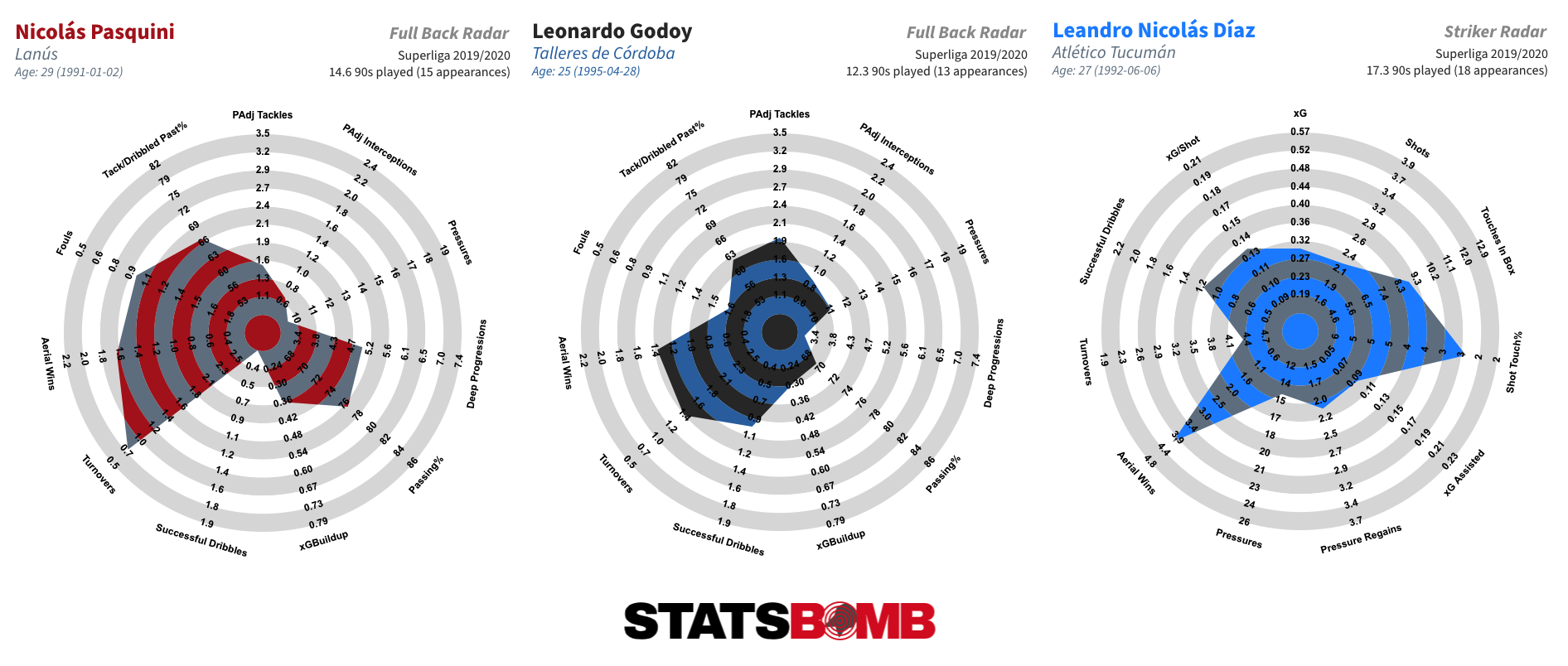 ND: Is there a particular signing you’re interested to see at their new club? VM: Maybe Edwin Cardona at Boca, to see how he fits into the team given that his characteristics, more suited to combination play, seem, in theory, pretty incompatible with Russo’s style of play. At San Lorenzo, it will be interesting to see how Franco Di Santo adapts to Argentinian football after spending his entire career outside the country. ND: In recent years, Di Santo has been a striker of few shots and few goals, so he shouldn’t be expected to score a lot. We’ll have to see what kind of role Soso has in mind for him.
ND: Is there a particular signing you’re interested to see at their new club? VM: Maybe Edwin Cardona at Boca, to see how he fits into the team given that his characteristics, more suited to combination play, seem, in theory, pretty incompatible with Russo’s style of play. At San Lorenzo, it will be interesting to see how Franco Di Santo adapts to Argentinian football after spending his entire career outside the country. ND: In recent years, Di Santo has been a striker of few shots and few goals, so he shouldn’t be expected to score a lot. We’ll have to see what kind of role Soso has in mind for him. 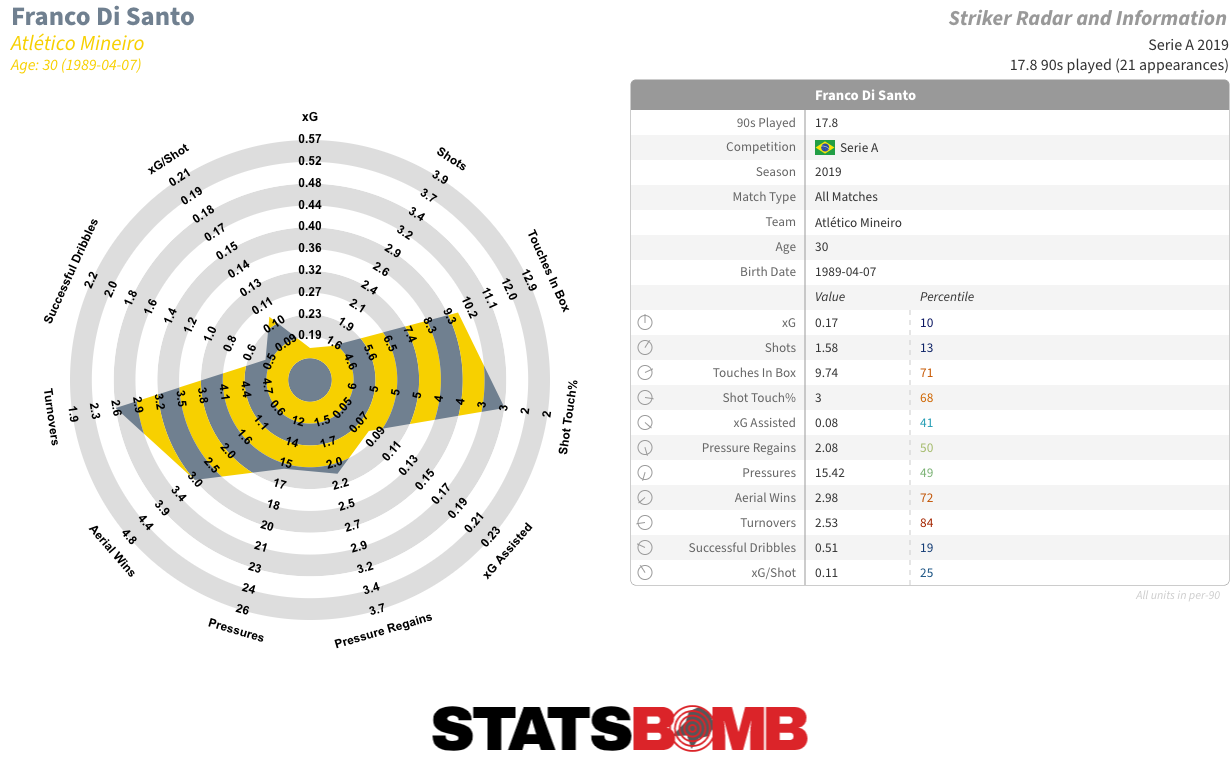 Who are the young players to keep tabs on? VM: At Racing, it will be interesting to see if Benjamin Garré, after showing promise at the back end of last season, is able to secure himself a starting berth and confirm what that run implied, namely that he is a skilled winger, incisive in one-on-one situations. It is obligatory to follow Thiago Almada. The Vélez player is ready to take a further step forward and become what he’s already hinted at becoming: a crack. He’s a skilled dribbler, incisive in one-on-ones, and with a good final pass. He is more than happy to take on the responsibility of generating advantageous positions for his team high up the pitch.
Who are the young players to keep tabs on? VM: At Racing, it will be interesting to see if Benjamin Garré, after showing promise at the back end of last season, is able to secure himself a starting berth and confirm what that run implied, namely that he is a skilled winger, incisive in one-on-one situations. It is obligatory to follow Thiago Almada. The Vélez player is ready to take a further step forward and become what he’s already hinted at becoming: a crack. He’s a skilled dribbler, incisive in one-on-ones, and with a good final pass. He is more than happy to take on the responsibility of generating advantageous positions for his team high up the pitch. 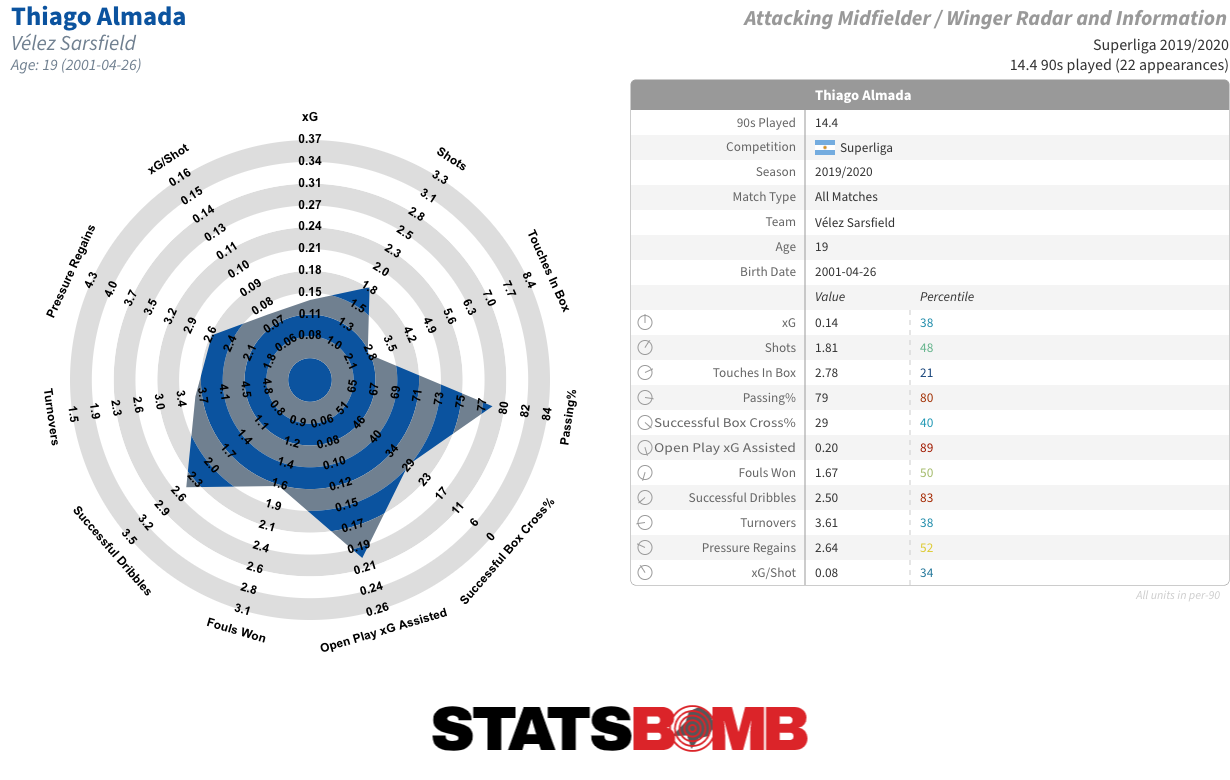 At Argentinos Juniors, Fausto Vera deserves a watch. The central midfielder of the Argentina Olympic team is technically sound, covers a lot of ground and reads play well, qualities that should allow him to establish himself as a great player for his club and also within the league. ND: With three goals and three assists in around 1,100 minutes of playing time, Tomás Badaloni of Godoy Cruz also looks like an interesting player to me. A goal or assist for every 180 minutes on the pitch is very good, particularly given that it runs in line with his expected output. We’ll see if he becomes a more regular starter in this tournament.
At Argentinos Juniors, Fausto Vera deserves a watch. The central midfielder of the Argentina Olympic team is technically sound, covers a lot of ground and reads play well, qualities that should allow him to establish himself as a great player for his club and also within the league. ND: With three goals and three assists in around 1,100 minutes of playing time, Tomás Badaloni of Godoy Cruz also looks like an interesting player to me. A goal or assist for every 180 minutes on the pitch is very good, particularly given that it runs in line with his expected output. We’ll see if he becomes a more regular starter in this tournament.  Great. Well, thanks again for your time Vicente. It's been a pleasure. VM: Thanks to you, Nick, and congratulations on the website. It provides very useful data with which to more deeply analyse the game.
Great. Well, thanks again for your time Vicente. It's been a pleasure. VM: Thanks to you, Nick, and congratulations on the website. It provides very useful data with which to more deeply analyse the game.
The Big 5 After 5: Premier League
We are five matchdays into a Premier League season that has already provided more than its fair share of incident and excitement. Here are some emerging trends. Goals, Goals, Goals Goals have been flying in from all angles, producing a series of seven-goal thrillers, five-goal thrashings and 3-3 draws that have enlivened the early running. With penalties included, there have been 3.58 goals per match. The total of 172 is 16 more than any other 48-game stretch in our data set (starting from the 2016-17 season). Will it continue? Probably not. Either through player adaptation or a more relaxed interpretation of the rules, the current rate of a penalty goal for every two matches is likely to eventually settle down to somewhere nearer the rate of one every three matches that is now pretty much standard across the major European leagues. It is also notable that non-penalty goals are running abnormally far ahead of expected goals (xG). The total of 147 is over 130% of the xG sum of 112.42. The furthest ahead that goals ran of xG in any consecutive 48-match sample last season was 111.35%. From 2016-17 onwards, the highest mark prior to the start of this season had been just over 120%. There are plenty of larger swings in smaller sample sizes, but in one of this size there has never previously been a swing of much over 20% at either end of the scale. All of which suggests that things will begin to slow down a bit as the campaign progresses. Is Anyone Good? It’s a fair question to ask. Liverpool and Manchester City were the clear pre-season favourites to occupy the top two positions, but both of them have already suffered heavy defeats -- City 2-5 at home to Leicester; Liverpool 2-7 away at Aston Villa. Manchester United have lost twice in four matches, including a 1-6 thrashing by Tottenham Hotspur; Chelsea are still just as open as they were last season and have carried a negative xG difference through their opening five fixtures. We could go on. Mikel Arteta has now had nearly a full season of matches on the Arsenal bench and while they do look more structurally sound to the eye, their numbers are still middling, and their shot volume is still poor. Leicester are fourth but have mediocre metrics. Only Aston Villa and Everton have traversed the opening weeks of the season undefeated. Spurs have very good metrics, but as with everything at this stage, it is too early to tell if that really means anything. Particularly so given that their numbers were so poor last season, and with the boost of that 6-1 win over United (3.07 to 0.16 on the non-penalty xG) to account for. West Ham have also looked good, as have Brighton by the numbers but less so by results. It will take at least another 5-10 matches for everything to shake out and give us a clearer idea of which teams are genuinely good and bad, maybe longer given the strange circumstances of the season. Once we get to that point it wouldn’t be at all surprising to see Liverpool and City again emerge as the league’s most impressive teams. Even with that Villa defeat on their record (a 3.91 to 1.77 defeat on xG), Liverpool have been so dominant in their other matches that they still have an overwhelming positive shot and xG difference. Their system is now arguably strong enough to absorb Virgil van Dijk’s absence, particularly once Alisson returns in goal. City’s attacking output hasn’t been great to date, but Pep Guardiola has done plenty of tinkering with the lineup and can be expected to eventually settle upon a workable formula. 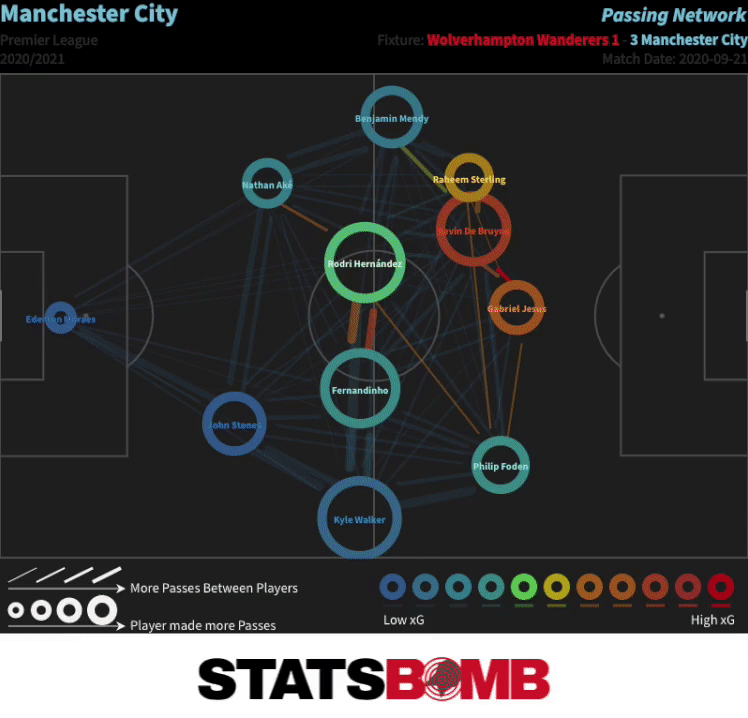 James Rodríguez Shines Everton’s purchase of James Rodríguez from Real Madrid was one of the more enticing off-season arrivals to the Premier League, and he has hit the ground running with three goals and three assists in five appearances. That is well ahead of his expected output, so he shouldn’t necessarily be expected to continue producing direct goal contributions at that rate, but even his underlying output has so far represented a clear improvement on the creative options Everton had last season. The sample size is very small, and so some variation should be expected over the course of the campaign, but on a per 90 basis, Rodríguez currently leads Everton in key passes (both from open play and set pieces), xG assisted and passes into the penalty area, in addition to also being the player who has most often moved the ball forward into the final third. All that while also getting off nearly 2.5 shots per 90. Reunited with Carlo Ancelotti, he has immediately become the team's attacking hub. Last season, no Everton player provided over two key passes per 90; Rodríguez has so far produced three. We certainly know a guy who’d relish the opportunity to work with a player capable of such quality deliveries from set pieces, particularly with a target like Yerry Mina on the other end of them.
James Rodríguez Shines Everton’s purchase of James Rodríguez from Real Madrid was one of the more enticing off-season arrivals to the Premier League, and he has hit the ground running with three goals and three assists in five appearances. That is well ahead of his expected output, so he shouldn’t necessarily be expected to continue producing direct goal contributions at that rate, but even his underlying output has so far represented a clear improvement on the creative options Everton had last season. The sample size is very small, and so some variation should be expected over the course of the campaign, but on a per 90 basis, Rodríguez currently leads Everton in key passes (both from open play and set pieces), xG assisted and passes into the penalty area, in addition to also being the player who has most often moved the ball forward into the final third. All that while also getting off nearly 2.5 shots per 90. Reunited with Carlo Ancelotti, he has immediately become the team's attacking hub. Last season, no Everton player provided over two key passes per 90; Rodríguez has so far produced three. We certainly know a guy who’d relish the opportunity to work with a player capable of such quality deliveries from set pieces, particularly with a target like Yerry Mina on the other end of them. 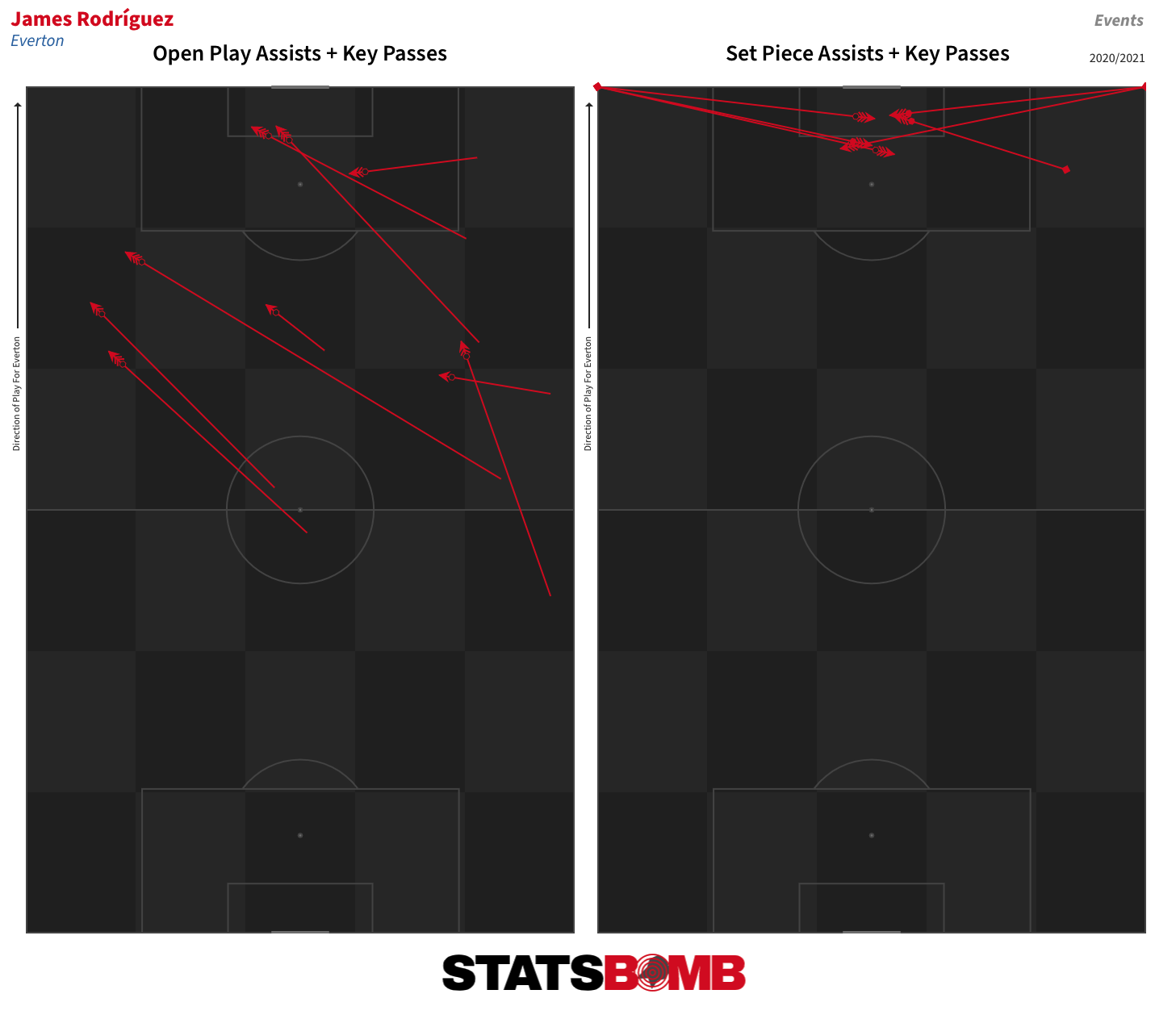 Everton have so far combined good results with very solid metrics, and that despite playing both Spurs and Liverpool across their opening five fixtures. As we've already said, we need a larger sample of matches before we can really start to draw any sort of meaningful conclusions on team quality, but Everton’s underlying numbers were better than results last season, and with Rodríguez on board, top eight should be their minimum aim.
Everton have so far combined good results with very solid metrics, and that despite playing both Spurs and Liverpool across their opening five fixtures. As we've already said, we need a larger sample of matches before we can really start to draw any sort of meaningful conclusions on team quality, but Everton’s underlying numbers were better than results last season, and with Rodríguez on board, top eight should be their minimum aim.
